The Olympus Trip 35 Review: Everything You Need To Know
I’ve worked with many Olympus Trip 35s over the years and I’ve discovered the pros and cons of this brilliant little rangefinder camera!
The Olympus Trip 35 is so popular because it’s very easy to use, it has a great lens and it’s ideal for the novice photographer. Also, the Olympus Trip 35 is one of the only 35mm cameras powered by the sun, making it really handy to take on holiday with you. Since 1967 10 million units have been sold, which is a tremendous amount even today.
If you want to know how this camera compares to others, how much you should be paying, some of its common issues and much, much more then read on!
I’ve worked with a hell of a lot of Trip 35s over the last few years and I like them because they’re really simple. If there’s something wrong with a Trip 35 I usually know it pretty much instantly because they aren’t especially complicated.
I’ve sussed out all the common issues, what can be fixed easily and what spells the end for an individual Trip 35. Usually, it’s lens fungus or an unreactive aperture that means doom for this little camera.
After years of working with them, I took one to the south coast of England to do a full review and I was actually pleasantly surprised by it. As you’ll see throughout the article, there are actually some good pictures that came from this ancient camera.
Some shots were let down by the very real limitations of this camera but on the flipside, due to the brilliant 40mm Zuiko lens, when the exposure is correct, its shots are great.
There are a lot of pros and cons to this camera so it’s well worth reading up on it to figure out if it’s the right fit for you. I enjoyed shooting it more than I expected but it wouldn’t be a camera that I’d rely on regularly.

Olympus Trip 35 Specs
Format – 35mm
ISO – 25 – 400
Battery – Solar Powered Selenium Battery
Exposure – Automatic
Shutter Speeds – 40 – 200
Flash – Hot Shoe
A Brief History Of The Olympus Trip 35
Introduced in 1967 and rolling on until 1984, the Olympus Trip 35 was completely ahead of its time. Sporting a solar-powered light meter in the late 60’s was pretty special.
Of course, Olympus’ market audience was pretty obvious, being named ‘Trip’, it’s kind of spelt out for you. Strong, reliable, doesn’t need any batteries, anyone could use it, that pretty much ticks all the boxes when it comes to a holiday camera.
Incredibly, over 10 million Trips were sold (Up for debate) and of course, they’re still being bought and sold to this day.
How Does The Olympus Trip 35 Battery Work?
The Olympus Trip 35 is powered by the sun using a selenium light meter which is the ring around the lens. This powers the light meter and allows the camera to choose the shutter speed and aperture (depending on which settings you have on). This would have been very unusual in its time but the fact that it’s still reliable today is brilliant.
Is The Trip 35 Lens Good?
Yeah, the Olympus Trip 35 has a pretty good lens but I’ve got to say, there are quite a few drawbacks. The lens itself is a beautiful 40mm 2.8 Zuiko lens, it’s pretty high quality for a camera that feels like a point-and-shoot.
I’d say the main drawback is that the focus is zonal and you only have 4 options. You should be able to see above, there’s a picture of one person, then two, then a group and then a landscape symbol. These are your focus options and it’s basically, 1.5m, 2m 3m and 6m and beyond.
This does limit the camera quite a lot but you’ve got to forgive a 50-odd-year-old camera sometimes.
The focal length is interesting, 40mm is pretty unusual but it’s still just wide enough to take the kind of pictures you’d usually take when you go on your holidays. It’d probably be preferable to have a 35mm lens but beggars can’t be choosers.
The Olympus Trip 35 Compared To The Olympus OM10
It’s worth comparing the Olympus Trip 35 with the Olympus OM10 as they’re currently at similar prices.
The Olympus Trip 35 isn’t that similar to the Olympus OM10, the Olympus Trip 35 is a small point-and-shoot rangefinder and the OM10 is an SLR however, it’s good to see what the Olympus Trip 35 is like in comparison to another well-known camera.
The Olympus OM10 would provide much better shots as it has better quality lenses and more control however, the Olympus Trip is more convenient, more compact and easier to use.
How Much Is The Olympus Trip 35 Worth?
Currently, the Olympus Trip 35 is worth around $100-125 or £70-100. You can of course get the Trip 35 for less if you try bidding for it on eBay or search thrift stores and flea markets but it’s worth trying to make sure that your Trip 35 is all working correctly.
What Kind Of Photography Is The Olympus Trip 35 Best For?
The Olympus Trip 35 is unsurprisingly best for travel-type photography. This camera was made with travel in mind as it’s small, compact, strong, easy to use and doesn’t require any batteries. Otherwise, this is also a good camera for day-to-day use. Photographers like David Bailey championed the Olympus Trip 35 believing that it was an incredibly high-quality camera.
Although the Olympus trip 35 has a great lens it’s not necessarily overly accurate and it’s not easy to focus correctly so despite the fact that it has a 2.8 lens it doesn’t mean it’s very likely that you’ll be able to focus correctly close range and get the most out of that lens.
This is not necessarily ideal for more professional types of photography and is definitely better to be used in day-to-day life and travel photography.
Is The Olympus Trip 35 Fully Manual?
The Olympus Trip 35 has two settings, one is an automatic setting that chooses your aperture and shutter speed for you, it decides between a shutter speed of 40 and 200 and between apertures of 2.8 and 22.
Alternatively, you can decide the aperture and the shutter speed will be decided by the camera. All focusing is manual and all ISO needs to be changed manually.
How To Use The Olympus Trip 35
Olympus Trip 35 is a very simple camera to use once you get the hang of it, until then understanding its limitations can be slightly hard.
If your camera seems not to be working properly try to leave it in the sun for some time to effectively charge its battery.
To open the back of the camera there is a small lever on the bottom of the side of the camera which just needs to be pulled down until the back pops open.
To change the aperture just rotate the ring at the base of the lens, this ring will show numbers from 2.8 two 22. If you want to shoot in automatically then turn it all the way around until the red ‘A’.
To change the ISO you just need to rotate the ring on the outer edge of the lens until you are to the correct ISO.
In order to focus you need to rotate the black ring on the lens. The closest focus mode is portrait mode, then there is middle-range portrait row mode, next, there are people standing further away from you and finally, there is a full landscape mode.
To attach a flash you simply have to slide it into the hot shoe located on the top middle of the prism.
To shoot and wind on you just have to press the shooting button on the top of the camera and then wind the black winder on the back of the camera until you can’t wind it any further.
To rewind the film you must first press the black button on the bottom of the camera to release the film and then wind the silver winder on the top left of the camera all the way back until it feels loose.
Common Faults Of The Olympus Trip 35
As the Olympus Trip 35 is a very old camera it has a number of common faults, hopefully, I can shed some light on these and help you avoid them or potentially fix them.
Commonly the red flag of the Olympus trip 35 will stop working, the red flag usually shows you when the scene would be too under-exposed. The red flag would appear at the bottom of the viewfinder when you are looking through it and would usually stop you from taking a picture if it’s too dark.
Sometimes the lens won’t react correctly to light, this is a great thing to check because if this is happening then it’s not really something that you can stop and it will ruin your photos. If this is happening the only advice I can give is to put it in the sun for a bit to see if this charges your selenium battery.
It’s likely that the light seals have worn away unless you bought your camera from a reputable dealer. You will probably have to replace a small number of light seals just to ensure that you do not get light leaks, this is fairly easy and if you want to find out how to do it then go to this link .
Lastly, the lens may have fungus and if the fungus is internal and it’s not something that would be easy to fix it would be much simpler just to get another one.
Final Word On The Olympus Trip 35
This is a great camera for travel and is certainly a camera to consider using. Personally, it’s not my kind of camera, I prefer more control and this just doesn’t cut it for me!
For a camera of its age, it truly is fantastic, a solar-powered vintage wonder that can still produce some beautiful shots!
Leave a Reply Cancel reply
Your email address will not be published. Required fields are marked *
Save my name, email, and website in this browser for the next time I comment.
Hey! I've been shooting film for a very long time and throughout all of my 20's it's been my main format. In 2019 I started to buy and sell film cameras and I became a top rated seller on Etsy and eBay. I've built up a wealth of knowledge about different kinds of film cameras and their common issues.
Since I started photography I've produced a number of zines/prints and more recently made a book called 'So Far So Good'.
I started this website in late 2021 with hopes of helping out people who had been looking for similar information to me and so far, I'm really enjoying it.
Similar Posts
The 12 best budget 35mm film cameras in 2023.
After working with film cameras for years, I’ve got first-hand knowledge about what’s good and what’s not in the camera market. There are so many film cameras out there, it’s tough to know what you should go for! So I’ve put together this guide of some of the best budget film cameras to make your…
Olympus Superzoom 70g/76g/80g/100g/105g Review – Are They Good?
Date written – 28/08/2023 I’ve been shooting film for 7 years now and over that time I’ve had a lot of experience with Olympus Superzooms. The Olympus Superzoom G series is comprised of zoom point-and-shoot cameras with 38mm to 70-105mm F 3.7 to F 9.5 lenses. They’re reliable, compact and easy to use, making them…
Olympus OM1 VS OM2 – What’s The Difference?
Over the years I’ve come across a lot of OM1s and OM2s and I’ve discovered the pros and cons of these classic cameras. The Olympus OM1 is a small, fully manual SLR camera with shutter speeds from 1s-1/1000s and the Olympus OM2 is a super compact, auto/manual SLR camera that has an electronic shutter. There…
The Pentax ME Super Review: Everything You Need To Know
I’ve shot and tested a hell of a lot of Pentax ME Supers over time I’ve got to grips with this fantastic SLR, this has provided me with great insight on this compact king. The Pentax ME Super is one of the best 35mm Aperture Priority cameras ever made. Many people agree that the Pentax…
The Lomography Apparat Review – Everything You Want To Know
I took the Lomo Apparat out for a spin so I can show you how to use it and get the best shots with it and find out if it’s worth the price! The Lomo Apparat is a film camera that Lomography released in 2022, it comes with a massive range of accessories and attributes…
Kodak Portra 160 VS Kodak Ektar 100 – What’s The Difference?
I’ve been shooting film for over 7 years and over that time I’ve shot a lot of Ektar 100 and Portra 160 and found the small differences between the two. Kodak Portra 160 has fine grain, pastel colour saturation, perfect skin tones and brilliant dynamic range, making it perfect for a number of different types…

- 35mm Lenses
- Camera Reviews
- Point and Shoot
Olympus Trip 35 – Camera Review
Josh solomon.
- October 3, 2016

As enthralling as photography can be, long days, months, and years spent shooting can wear you out. In the worst case, it can lead to a photographic malaise that can dismantle even the most well-built minds from the inside out. It can render the best shooters incapable of even the simple task of pressing a shutter button. It’s shooter’s block, our equivalent to writer’s block, and it hit me hard over the summer.
I jumped out of bed one morning full of energy, ready to take on the world with my trusty Nikon F and Leica M2. But instead of plunging into a world filled with beauty, intrigue, and possibility, I found my surroundings cold, ugly, and indifferent. The images I tried to form seemed trite and overplayed, and I soon lost confidence in my ability to make a decent picture. Even the storied reputations of my F and M2 failed to inspire me. Every time I peered through their viewfinders I saw nothing but dust in the pentaprism and emptiness between the framelines.
Sufficiently depressed, I decided to stay home and put my cameras on the shelf. And it was while I was lying face down on a pillow listening to the opening lines of Chicago’s “Hard To Say I’m Sorry” that I realized I did, in fact, need a little time away. But I didn’t need a full-on vacation from the hobby itself – no, that would be too drastic. I just needed a change from the manual cameras that sat on my shelf. I needed an easier camera, and I had a feeling one camera in particular could fit the bill – the Olympus Trip 35.

The Olympus Trip 35 is a camera I’d heard a lot about but had never tried myself. Its reputation for ease of use and high quality seemed the perfect cure for my shooter’s block. And if the Trip 35 was the prescription, the Pasadena Camera Show was the pharmacy. There I found a beautiful Trip 35 for an absurdly low price, bought it, and quickly threw it in my bag.
One would think the Olympus Trip 35 would seem out of place next to legendary cameras like the aforementioned Nikon and Leica, but it actually fits right in. This camera, although not as capable as the other two, holds an equally lofty place in photographic history. Just as the F and the M defined the SLR and rangefinder genres respectively, the Trip 35 defined the point-and-shoot game. More impressive still, the Trip 35 actually outsold the Nikon F and the Leica M2 by millions. Take that, fanboys.
Olympus achieved these massive numbers by appealing to the casual shooter rather than pro photographers, specifically focusing on the new generation of moneyed vacationers. Racing from landmark to landmark and airport to airport, these sightseers simply lacked the time and interest needed to learn the boring particulars of photography required to operate a camera. Instead, they required a camera that was simple to use, but sophisticated enough to beautifully capture their memories.
Good design marries aesthetics to functionality, and the the camera gods couldn’t have picked a better company to bring the Trip 35 to life. Olympus’ design house, fresh off the ingenious half-frame Pen F, struck gold again with the Trip. The design is classic Olympus; clean-cut lines and an impossibly small form factor, the Trip wastes no time and gets straight to the point. It’s as well designed as any machine of its day, more impactful when we recall that the Trip came of age in an era where cameras were still fully mechanical, save for the occasional battery powered light meter. Automation seemed a distant (and expensive) fantasy, so when Olympus created a genuine auto-exposure camera out of primitive nuts and bolts, the world took notice. This was in no uncertain terms an engineering miracle.
The Trip 35 accomplishes this sorcery by determining the amount of light that enters a Selenium photo cell surrounding the lens, and choosing a correct aperture based on this reading. The camera then chooses a shutter speed of either a 1/200th or 1/40th of a second and we get a perfect exposure. When the camera’s incapable of making an acceptable exposure, a little red flag shows up in the viewfinder and the shutter locks out. The magic of this system is that it takes all exposure-related worry out of our minds. We don’t have to agonize about aperture, shutter speed, or even battery life, a godsend for vacationers and anxious photo geeks.
But before we experience it, it’s quite easy to question the Trip 35’s simplicity. After all, how accurate could a camera this old and primitive be? And could the lens be good enough for our 21st century eyes? As I drove home from the camera show, my new Trip in the passenger seat next to me, these questions rolled through my mind. I really needed this camera to be decent, if I was to pull out of my photographic death spiral.
Just then, I received a text message from my sister. Can you pick up some pork buns in chinatown? thx. With this, I had my mission; buy some pork buns, shoot the Trip, and see if this ancient camera could walk the walk.
The first thing I noticed was its build quality. Comprised of metal and plastic, the Trip 35 is solid, but never heavy; lightweight, but never flimsy. The only disappointing aspect of the camera’s feel is its film advance wheel. A dinky plastic affair reminiscent of disposable cameras, this lackluster cog is forgivable when we remember that the Trip was built to be a consumer-level camera.
Peering through the viewfinder showed bright frame-lines with tick marks both for up-close shots and for landscape shots. These are helpful in view of the Trip’s lack of automatic parallax correction. Having used fancy Leica , Nikon , and Contax rangefinders renowned for brightness and clarity, the Trip’s viewfinder beats most of them. Its relative simplicity is a nice change from the cluttered and overly complex viewfinders of other machines. The Trip 35 also features a small window in the bottom right of the VF (affectionately dubbed the “Judas Window” by Trip 35 disciples) which shows both the chosen aperture and exposure setting on the camera.

So far, so good. But how was I to determine focus? I quickly realized that the Trip’s a scale-focus camera, which is not ideal for accuracy. But before I started feeling like Olympus left me all alone and helpless, I realized that they were kind enough to provide some handy distance-measuring tools. Settings along the lens barrel show a picture of one person for portraits, two people for pictures of two people, three people for group pictures, and a mountain symbol for everything in the distance, including mountains. I stopped hyperventilating, and realized that, for a point-and-shoot camera, this is more than enough. And for all you nitpickers, Olympus also included precise distance measurements in both meters and feet on the underside of the lens. Phew.
Once shooting the Trip started to shine, and I was easily able to focus on exactly what matters most in photography – composition. From the first frame I found myself joyfully snapping away at whatever tickled my fancy, even though I didn’t know what aperture values and shutter speeds the Trip 35 was choosing. Frankly, I didn’t give a damn. All that mattered to me was finding different angles, new ways to play with light, and how to capture Chinatown’s unique charm. It felt like with each and every frame, the Trip was dissolving my shooter’s block more and more, and I wanted to just keep shooting.
So the little Olympus and I danced through Chinatown’s colorful landscape, happily snapping away. In no uncertain terms, it was the most fun I’d ever had with a camera. Even though the heat of the afternoon beat on my shoulders and the sweat sizzled on my brow, the Trip 35 and I ran through the city without a care in the world. The streets led us to the door of a steamy Chinese restaurant, then a pile of steaming pork buns, then back to the equally steamy interior of my car. I didn’t care how long the journey took or how much fluid I lost in that heatwave. It seemed like I sweated out my shooter’s block, and I eagerly raced home to deliver the buns, and develop the film.
But something was nagging me about the camera the entire way home; the focus issue. Had I gotten the focus correct for every shot? How was I to trust those markings? How could I possibly live without a focusing aid? Anxiety began to rear its head again and I had to stop myself from speeding over to a one-hour photo lab to assuage my fears. I gripped the steering wheel tight and told myself to trust the Trip. Besides, I still had a job to do. These pork buns weren’t going to deliver themselves.
After delivering and munching on said pork buns with my contented sibling, I decided to get the roll developed and scanned. My fears were partially founded. Some of the shots, especially photos of close subjects or darker scenes, came back fuzzy due to a combination of my poor distance estimation and the nature of the Trip’s exposure and focus systems. While the Trip automatically helps achieve sharp focus by selecting a smaller aperture for greater depth-of-field, this is only possible in bright light. As things get dark, the ability to shoot at a smaller aperture quickly disappears. In these situations it can be really difficult to nail correct focus. One minor consequence of this is that shooters with an affinity for portraiture and those sweet bokeh balls will probably be disappointed by this camera.

But expecting creamy bokeh and close range performance from the Trip 35 (or most point-and-shoots for that matter) is like expecting a ‘93 Honda Civic to outpace a Tesla Model S. It just won’t happen, and trying will lead to frustration. But just like that Honda, if you regard the Trip 35 as a reliable machine good for an occasional joyride, it will never disappoint. The Trip 35 is capable of a great many things , but we must be careful to recognize and respect its own limits.
When we get the focus right, the Trip’s fantastic 40mm F/2.8 Zuiko lens delivers in spades. The lens is a front-focusing Tessar type lens, which means that it’s very simple and very sharp, and it retains this sharpness edge to edge without chromatic aberration, spherical aberration, or any kind of distortion due to its simple optical formula and Olympus’s masterful execution. The lens’ quality even overcame the limitations of expired film, and ended up giving me some great results.
For whom is this camera best suited? First and foremost, the Trip 35 might just be the perfect camera for the casual photophile. Olympus built this camera to document the daily adventures of the everyman, and the Trip does this beautifully. And for experienced shooters, the Trip 35 can be a great way to break free of shooter’s block, or inject our shooting with something fun and carefree. It emphasizes the art of composition rather than the cold calculations of exposure, but even more importantly, it reminds us to relax, have a pork bun, and not take ourselves too seriously.
Want to try the Trip 35 for yourself?
Buy it on ebay, buy it on amazon, shop b&h photo’s vintage gear, follow casual photophile on facebook and instagram.
[ Some of the links in this article will direct users to our affiliates at B&H Photo , Amazon , and eBay . By purchasing anything using these links, Casual Photophile may receive a small commission at no additional charge to you. This helps Casual Photophile produce the content we produce. Many thanks for your support. ]
Share this post!
- Click to share on Facebook (Opens in new window)
- Click to share on Twitter (Opens in new window)
- Click to share on Reddit (Opens in new window)
- Click to share on Pinterest (Opens in new window)
- Click to share on Tumblr (Opens in new window)
- Click to email a link to a friend (Opens in new window)
- Camera Review
- film camera
- olympus Trip

Josh Solomon is a freelance writer and touring bassist living in Los Angeles. He has an affinity for all things analog. When not onstage, you can find him roaming around Southern California shooting film and humming a tune.
29 comments
Very nicely done.
Great review of the Trip! This is the camera that lured me away from Lomography and the whole low-fi aesthetic. While the metering system is somewhat primitive and the zone focusing can be imprecise, especially in low light, it’s obvious that all the money and work went into the lens. In the right circumstances it’s absolutely tack sharp. Once I started getting sharp images from my Trip, the Lomo LC-A+ and the Holga started looking a lot less appealing.
The Trip definitely has some big limitations but on its own terms it’s a great camera.
Here’s my Trip album on Flickr to get an idea.
https://www.flickr.com/photos/21156896@N07/sets/72157645739914959

Thanks for adding your Flickr album. It’s great for people to be able to see what these cameras can do in varied situations.
Thanks so much! Those images are fantastic; they really showcase what that lens can do. Funny you mention the LC-A+… ?
Thanks! The LC-A+ was the camera that got me back into using film after an extended dalliance with digital photography. I used it really heavily for about 2 years before becoming curious about other cameras. The fact that the Lomo is also a zone focuser made it very easy for me to switch to the Trip and the XA2.
Great write up Josh, and really nice album Neilson! I had to do a double take on some of those shots, especially the close up portraits, realizing that you had used a Trip.
I agree, what a great review and some fine shots on that flickr gallery. I’ve just bought my 50th Olympus Trip 35 and am steadily rebuilding them from head to toe. I’ve posted some reviews and other helpful reviews on my site https://trip35.co/
Great pictures from the Trip. You got to love these little cameras!
The Trip 35 was *made* for landscapes and group photos in good light outside. It’s really dang good for those things. For everything else, not so much! But like you, on a day when I’m just out and about shooting stuff, I find the Trip 35 to be big fun.
My last outing with my Trip 35: https://blog.jimgrey.net/2015/04/20/olympus-trip-35-revisited/
If I ever get on an airplane again I think I’ll be bringing this camera… We’ll see. Josh and your post have helped convince me. Thanks for sharing.
Great review of one of my favourite cameras and one of the best free cameras I’ve ever been given. The quality you can get from this little package has always astounded me, this is an example taken with just bog standard Poundland special film (Agfa Vista 200) https://the6millionpman.wordpress.com/2016/09/30/cardiff-bay-sunset-3/
And yet again I confess to being an Olympus fanboy.
Beautiful colors and range on that.
Great article Josh, and thanks for publishing it James. There wasn’t a link, but I started the Olympus Trip 35 users group on Facebook, here is the link. P.S. A few famous photogrpaphers in the group.
http://www.facebook.com/groups/OlympusTrip35
Hey my friend! Thanks for commenting. We did include a link there, it’s in the third to last paragraph where it says the Trip is “capable…” etc.
And for anyone down here in the comments, do check out the FB group. Amazing talent there shooting with all kinds of Trips.
The Trip Flickr group is worth checking out too. Lots of good stuff there.
https://flic.kr/g/5jsssh
Great write-up! I have three of these and, while I’m by no means a great photographer, I do love the pick-up-and-go nature of the Trip 35. For those who are interested, I spent an entire day refocusing the lens on one of mine;
https://teeritz.blogspot.com.au/2014/04/re-focusing-lens-on-olympus-trip.html
Almost drove me nuts!
That post is scary. You’re a brave man.
Bought a Trip after reading a recommendation by Ken Rockwell. At the time I thought I only ever needed one camera – an FE – and I had one. However, the Trip is great for other things. As you say, the pictures are so sharp. And its so easy to use.
I love my Trip 35. Fantastically sharp lens and incredibly easy to use! The zone focusing took a bit getting used to and I do still occasionally misfocus, but when that happens I embrace my inner William Klein. Also, my copy came with a lens cap and zipped up in a bag so the selenium is not at all worn out and the AE is spot-on. I actually trust shooting slide film in this camera more than any of my all-manual cameras!
Hi! Thank you so much. I am seriously considering to buy a Trip. I want to go traveling and bring a good camera. Do you think this one will do? And some people say it’s not really for taking photo’s in the dark/on parties. Are they right?
Thanks again 🙂
Hey Nikki! The Trip is the perfect camera for travel and casual outdoor shooting IMO, but it does suffer in low light without a flash. A little compact flash will help, and it does have a manual aperture override for accurate flash exposures.
If you’re going to be spending lots of time indoors I would suggest either picking up a cheap P&S with a built in flash, or upgrading entirely to a compact SLR/fixed-lens rangefinder with a fast (f/2 and under) lens for low-light shooting without a flash. Hope this helps!
Hello Nikki, I am the Admin of the Olympus Trips 35 Users Group, I recommend you join to get advice, and there are trustworthy sellers in the group.
See the website link below my comment
I’ve recently picked up aTrip 35 and have been very pleasantly surprised by the ease of use and picture quality. I even tried some low light close shots and had better results than I expected. Tip #1: use 400 speed film to increase versatility. You get more depth of field in any situation and therefore more focussing accuracy. You will also hold off the “red flag” for a stop or two. Tip #2: learn how to guesstimate the zone distances as accurately as possible. If you’re shooting close-up in lower light try to nail the actual distance e.g. set the lens on 1 meter and try to be 1 meter away. Use a tape measure at first so you can see what the distances look like. As the light falls or distances get closer then more accuracy is required from the photographer. Tip #3: remember that you can press the shutter button half way down to lock the exposure. Meter off a mid-tone then recompose and shoot. This will help with back lighting and other tricky light. Tip #4: try to shoot within the limits of the design and you will get good results. The Trip 35 was meant for family holidays and a whimsical approach to photography. If you require critical focussing or metering the Trip was never really designed for that. Enjoy!

Hi, Josh. Great writing. I enjoyed reading your review and laughed so much at the pork bun adventure! Thanks!
Thirty-seven years of shooting film and the Trip 35 was a camera I’d always ignored for being ‘too simple’. I spotted one in a local charity shop last week that was cased, boxed and in lovely condition and I got it for next to nothing. I ran half a roll of FT-12 ASA50 cinema film through and the results were far better than I expected. I started out on Olympus all those years ago (still use them) but I’m a bit ashamed of myself for ignoring this little gem. My 8 year old is just starting to take an interest in photography and this is going to be ideal for her.
Thanks for a great review and for pointing out a couple of little features I hadn’t spotted.
Quick pedantic note: In virtually everything I’ve seen online about the Trip 35, there’s one thing that nobody ever seems to say:
The Trip 35 is essentially the full-frame version of the earlier half-frame Pen EES and EES-2.
I had an EES-2 and it was a great shooter for an inexpensive camera. It worked exactly the same way as the Trip: the selenium meter around the lens chose one of two shutter speeds or raised a red flag if there wasn’t sufficient light; it had a four-icon zone focus lens; there was one manual speed for flash along with adjustable f-stops when not in Auto. Of course, the Trip had a different focal length lens to produce a full-frame image, but I suspect it’s of a very similar design to the EES-2’s. And note that the Trip 35’s top plate includes the EES-2’s hot shoe, along with the back cover/rewind knob from the Pen series (and frame counter from the Pen F series), and the viewfinder is essentially the same as the EES-2’s.
My point is: the Trip 35’s super-successful design wasn’t actually new, the camera was scaled up from the already successful Pen EES series.
Thank you… Now I’m on my way for fun an Mindfulness 🙂 A very brilliant text who give me interests and energy. Thank you 🙂
Just bought one, trying it out tomorrow. I would suggest to buy a tripod and a self-release cord, set it to A and just set for the distance. I used to carry a 110 film camera back in 1977 and was taught photography back in 1981 from a WW2 vet. Warhol used a Pentax 35afm because he could set a high iso without flash.
Leave a Reply Cancel reply
New york city and the half-frame 35mm olympus pen d, the cinematic point and shoot – minolta p’s (freedom vista) review, olympus xa2 – point and shoot 35mm film camera review.

Olympus Trip 35
The Olympus Trip 35 is a fully-automatic 35mm compact camera , manufactured by Olympus from 1967 [1] to 1984, during which time over ten million units were sold, [1] though this oft-quoted figure is likely to have included later plastic-bodied Olympus cameras with Trip branding, as the original Trip 35 had serial numbers going up to around 5,400,000. [2] The auto-exposure mechanism is effectively solar-powered by a selenium cell surrounding the lens, and consequently the camera runs without batteries. Until June 1978, the shutter button was silver-coloured metal. After that date, all Trips had a black plastic button.
- 1 Auto-exposure mechanism
- 3 Viewfinder
Auto-exposure mechanism
With the aperture ring set to "A", the camera operates as a program automatic with a working EV range of 8.32-17.4 at ASA 100. [3] Half-pressing the shutter-release button locks the exposure with both the aperture and shutter speed (of which there are only two, 1/40 and 1/200s) fixed by a delicate but accurate mechanism. As explained by one repair page ,
The combination of aperture and shutter speed that the exposure mechanism chooses depends on the amount of light available. The precise amount of light that triggers a change of the shutter speed is not documented in the user manual, but it is believed to be around EV 13. When brightness of EV 13 or more is detected, the Trip 35 will increase the shutter speed to 1/200 sec in preference to using a smaller aperture, and use a narrower aperture as light levels increase from there, presumably to avoid the diffraction effects that affect all 35mm cameras below f/11. [4] Below EV 13, it will use the 1/40 sec speed and widen the aperture for lower light levels. The camera will refuse to fire if there is not enough light, with a red plastic flag appearing simultaneously in the viewfinder. This mechanism makes it impossible to make the error of shooting with the lens cap in place.
When the aperture is set manually (primarily for flash photography), the shutter speed is set to 1/40th of a second. However, the meter is still active even in this "manual" mode. Setting the aperture manually merely sets the widest permissible aperture, and the auto-exposure mechanism may still choose to set a smaller aperture than this if it sees fit. [4]
Other than this, the camera offers no controls for setting exposure manually, though one can easily set exposure compensation by changing the film ASA dial to a higher or lower value.
The Trip 35 has a 40mm f/2.8 Zuiko non-interchangeable lens, with four elements in three groups. Ken Rockwell suspects this to be a front-element focusing Tessar . [5] This lens has a reputation for being extremely sharp, even in the corners; in Rockwell's tests, Costco-scanned Fuji ISO 400 print film loaded into this camera out-performed a Canon 17-40 f/4 L lens in the corners. [5]
The lens provides simple zone-focusing with 4 cute distance symbols marked on the top-left of the lens. These correspond to the real distance markings on the underside of the lens: 1 meter, 1.5 meters, 3 meters, and infinity. Filter ring is 43.5mm.
The viewfinder is an albada-type, with parallax markings for closer focusing. There is a second, very small window under this, nicknamed the "Judas window", which shows the current aperture setting and distance symbol which are on the lens barrel.
A small red flag will appear in the viewfinder if the auto-exposure mechanism decides there is not enough light and refuses to fire.
This camera's aperture blades (there are two blades) tend to be become sticky over time. Before purchasing an old Olympus Trip 35, ask the seller if the aperture is properly opening and closing at all values (f/2.8-f/22). This can be done by manually selecting each aperture value and half-pressing the shutter button. Otherwise, the lens unit would have to be disassembled and cleaned.
- ↑ 1.0 1.1 Olympus' history of EE-equipped cameras (archived)
- ↑ Serial numbers collected by the Olympus Trip Flickr group
- ↑ Specifications in the user-manual.
- ↑ 4.0 4.1 See the Trip 35 program graph , and the explanation in this thread .
- ↑ 5.0 5.1 http://www.kenrockwell.com/olympus/trip-35.htm
- Manual available from UCL
- Olympus Trip 35 group on Flickr
- A modification that allows a 1/200 shutter speed with manual aperture control
- Illustrated instructions for repairing a Trip 35
- Trip 35 in the Olympus Global History (archived)
- This is a trip at Classic Cameras by RaúlM.
- Lionel's Olympus Trip 35 page in French at 35mm-compact.com
- Olympus Trip 35 on www.collection-appareils.fr by Sylvain Halgand (in French)
- Flickr image
- Image by rick soloway
- Japanese 35mm viewfinder
- Image by Michele M. F.
- Image by Hans Jan Dürr
- Image by vincentnip
- Image by Ênio Resende
Navigation menu
Personal tools.
- View source
- View history
- List of Companies
- Community portal
- Recent changes
- Random page
- What links here
- Related changes
- Special pages
- Printable version
- Permanent link
- Page information
- This page was last edited on 7 November 2021, at 07:11.
- Text is available under GNU Free Documentation License 1.3 ; other licenses apply to photos.
- Privacy policy
- About Camera-wiki.org
- Disclaimers
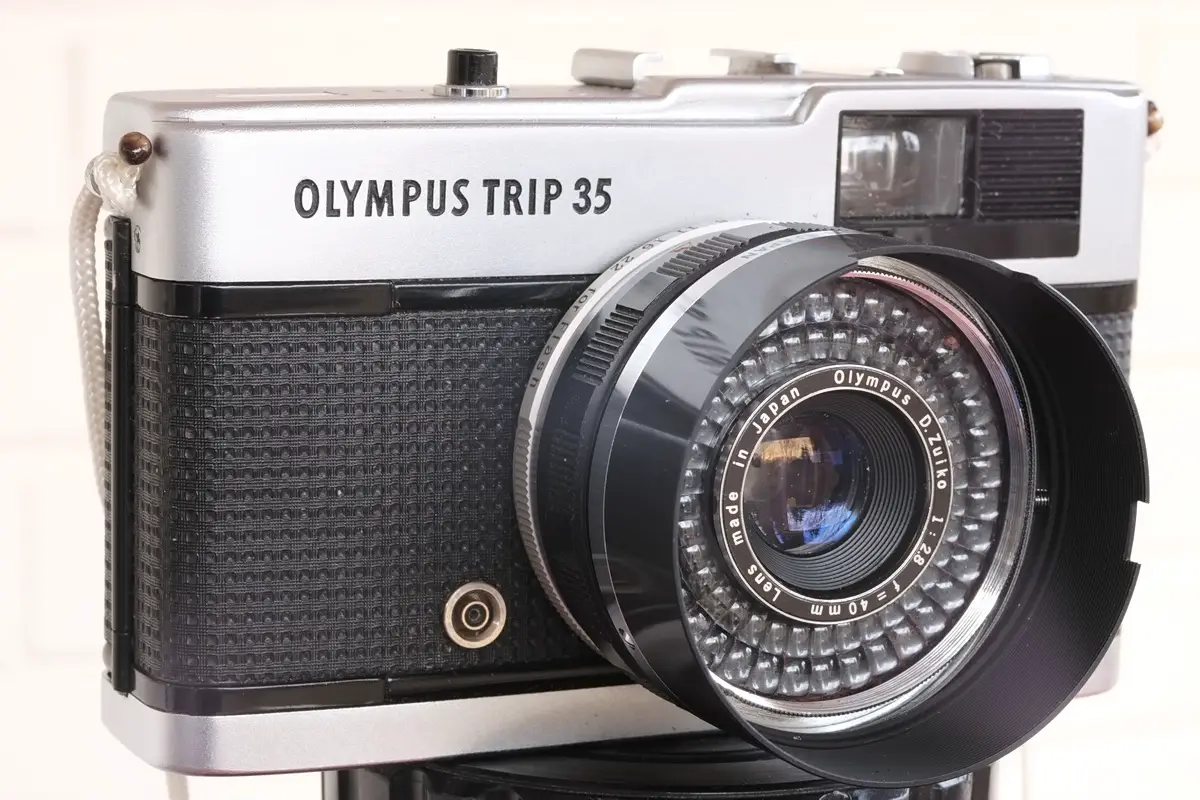
Olympus Trip 35 Review – Learning to be More Spontaneous – by Andrew Morang
5 May, 2018
Post Categories:
Share this post:
In the past, I always used manual cameras. I measured the light, set the exposure, and focussed myself. Even in a car, I like to be in control and only drive manual transmission, which is almost unheard of in the United States. The point-and-shoot craze of the 1990s completely passed by me. But now I have this funny little Olympus Trip 35, a “point-and-shoot.”
Why I bought it is a bit of a story. In preparation for a 2017 trip to Nepal, I sent my Leica IIIC off for repair. But in case it would not be ready in time, I bought three inexpensive compact 35s from the ‘Bay. A Minolta was dead on arrival, but a Yashica Electro 35CC and an Olympus Trip 35 were fully functional. However, the Leica was overhauled in time for Asia, so the Trip stayed home. But I was curious to see if the Trip 35 was as good as so many reviewers claim.
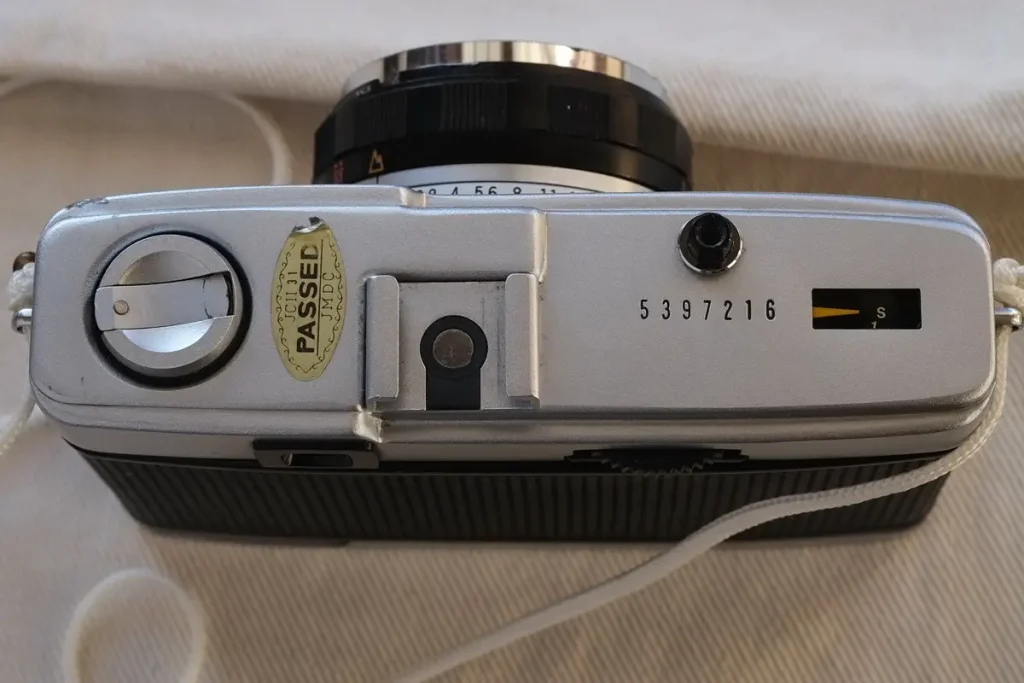
As you can see, the Olympus Trip 35 is a simple device. Film winding is via a wheel on the back. Exposure is automatic, controlled by a selenium meter that is coupled to the aperture and shutter. If the light is too low, a red flag pops up in the finder to tell you that the shutter button is locked. (If you buy one from the auction site, make sure the red flag feature works; that means the selenium cell is functioning.)

Limitations
This little Olympus Trip 35 has limitations:
- There are only two shutter speeds: 1/40 sec and 1/200 sec. The camera sets them for you based on the amount of light, but if you turn the aperture dial off “A” to one of the f-stops, the shutter is 1/40.
- The light meter, being a selenium cell, does not have low-light capacity. The selenium cell (behind the bubbly plastic) surrounds the lens. If you want a low-light camera, you need one with a battery-powered CDS or SBC cell.
- The viewfinder does not have a focus aide, so you need to estimate the distance. The lens has some symbols to help you, such as a mountain or a person. Really, it is not difficult, especially with the semi-wide 40mm lens.
- The filter size is a unique 43.5mm fine pitch. Why did Olympus do this, to sell their own unique size? Color filters are very hard to find, and they do not screw in easily. Maybe the assumption was that most casual users took color negative film and did not care about filters.
- For some unknown reason, hoods are unobtanium in the USA. I had to order one from a UK vendor, and it cost as much as the camera did.
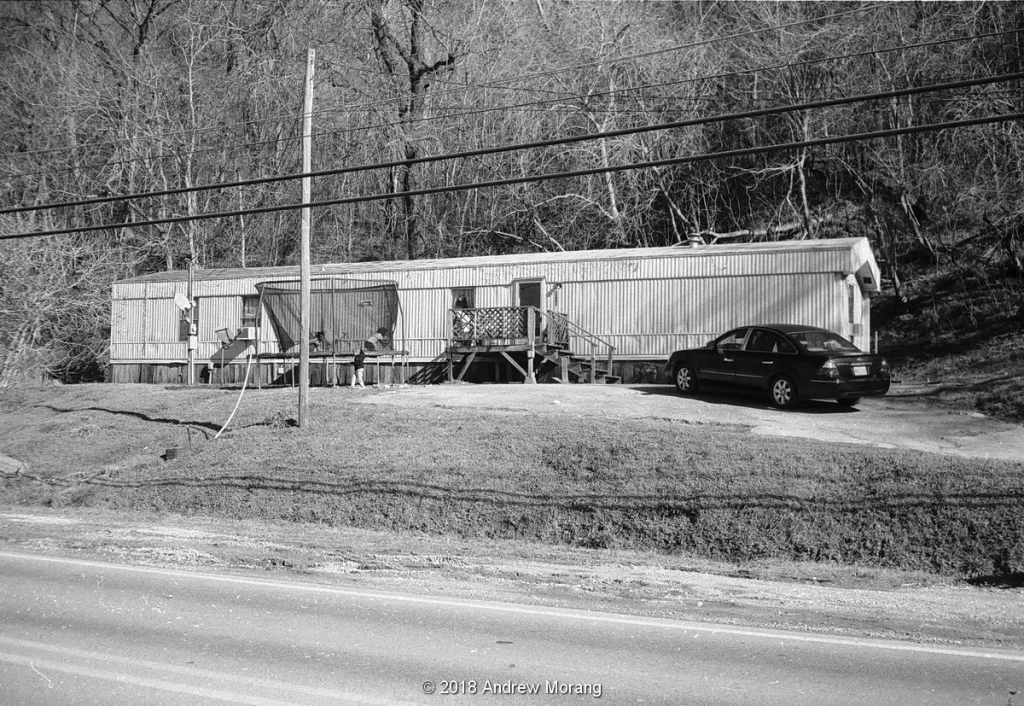
The Trip 35 In Use
Regardless of these limitations, this Olympus Trip 35 is fun. With this little Trip 35, you can leave the focus at infinity (the mountain symbol), raise the camera to frame, and snap away. It is so simple, so liberating. I can take it with me on the bicycle, stop where I see something interesting, and snap a photograph. But I noticed I still support it in the same way as my bigger cameras: left hand cradling the lens and right hand holding the right side and index finger on the shutter button. Solid grip, no breathing, and careful press. So maybe I am really not spontaneous, but it is less of an effort than one of my “serious” cameras.
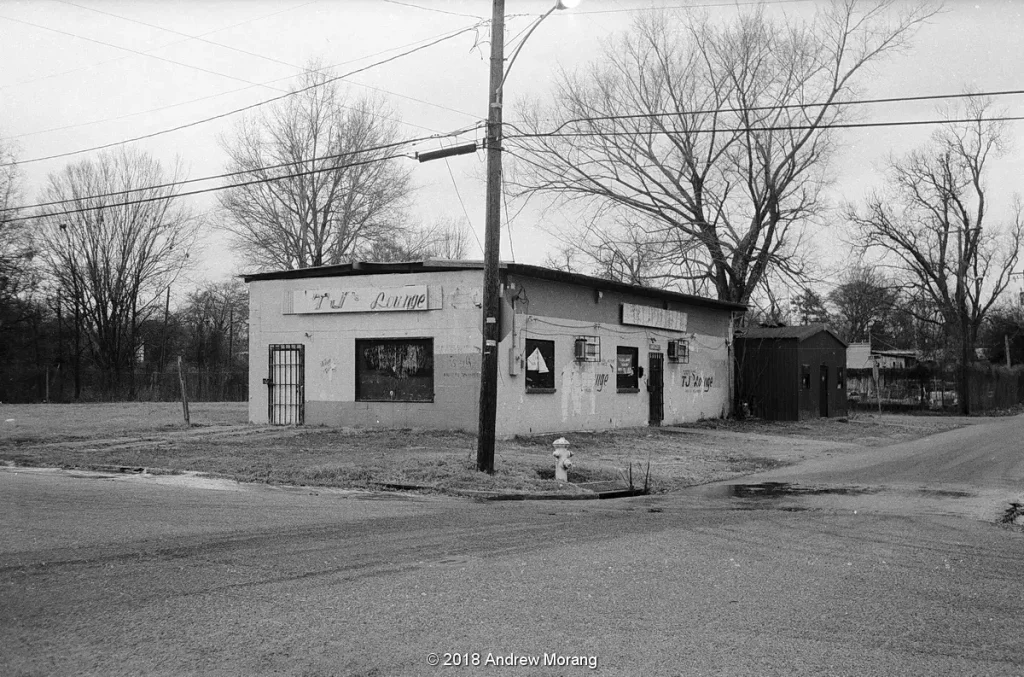
At low light, you can see the limitations of the Olympus Trip 35. Contrast is a bit low, and you should use a hood. And once the red flag pops up and locks the camera, your only option is to move the aperture control off “A” to 2.8 and hope the exposure will be adequate. Because I often take pictures in low-light conditions or in old buildings and factories, this little Trip 35 is rather restricting. Also, although there is no indication of when the selenium meter has set the lens wide open, the edges of the frame in dusk are a bit soft. I assume the lens is close to 2.8. It is certainly not as well corrected as a 35mm Summicron or 35mm Super-Takumar, but, of course, those are more sophisticated and expensive designs.
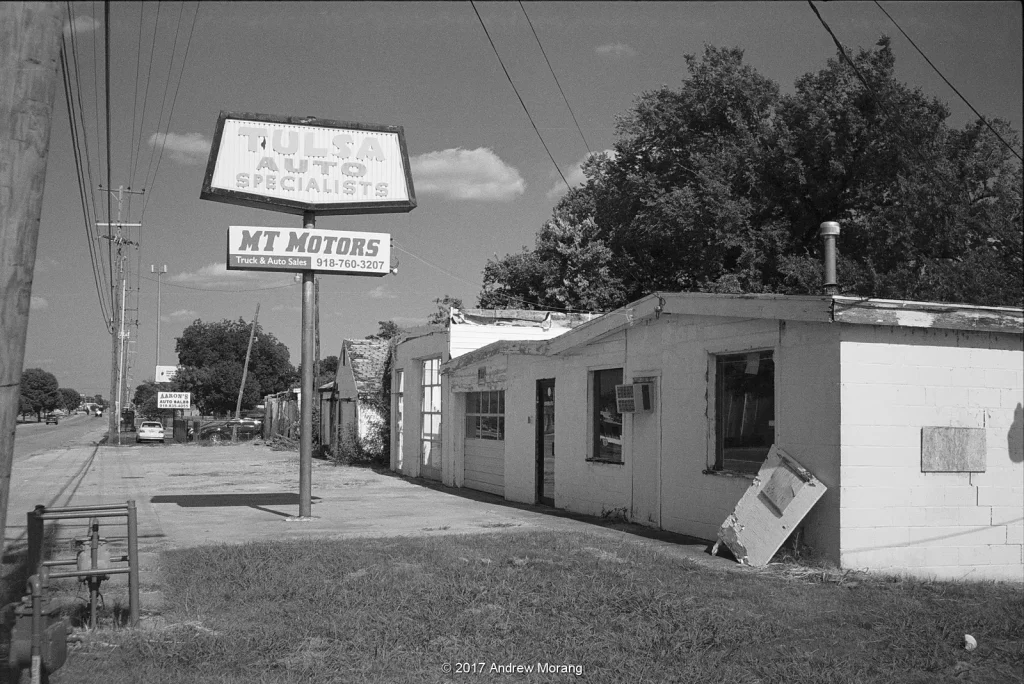
Despite some limitations, do not let me dissuade you from trying the little Olympus Trip 35. They are fun, inexpensive, and take good photographs. Thank you for reading, and thanks Hamish for letting me post these ramblings.
For more urban decay photography, please see: https://worldofdecay.blogspot.com
Find more similar content on 35mmc
Use the tags below to search for more posts on related topics:
Contribute to 35mmc for an ad-free experience.
There are two ways to contribute to 35mmc and experience it without the adverts:
Paid Subscription – £2.99 per month and you’ll never see an advert again! (Free 3-day trial).
Subscribe here.
Content contributor – become a part of the world’s biggest film and alternative photography community blog. All our Contributors have an ad-free experience for life.
Sign up here.
About The Author
Paul Graham on Olympus Trip 35 Review – Learning to be More Spontaneous – by Andrew Morang
Comment posted: 06/05/2018
Leave a Reply Cancel reply
Your email address will not be published. Required fields are marked *
Save my name, email, and website in this browser for the next time I comment.
Notify me of new posts by email.
Kodachromeguy replied:
Yes indeed, a step-up adapter is a possibility. I considered that, but there are two problems with the Trip 35. First, The genuine Olympus hood will not fit over the adapter ring, so then you need a screw-in hood that fits the filter that you finally adapt. Second: the viewfinder is partly obscured. Olympus used this size for several of their cameras, so once upon a time, there may have been more 43.5 filters available.
Philip Brooke on Olympus Trip 35 Review – Learning to be More Spontaneous – by Andrew Morang
Comment posted: 09/05/2018
Nigel Cliff on Olympus Trip 35 Review – Learning to be More Spontaneous – by Andrew Morang
Comment posted: 22/05/2018
Recommended reading : Down the Road on Olympus Trip 35 Review – Learning to be More Spontaneous – by Andrew Morang
Comment posted: 05/03/2020
Time to Meet Some of the Most Gorgeous Olympus Trip 35 Cameras Ever! – Photography on Olympus Trip 35 Review – Learning to be More Spontaneous – by Andrew Morang
Comment posted: 30/10/2020
Leave a Comment
Related Posts

13 April, 2024
By Molly Kate

25 March, 2024

7 March, 2024
By AndreArma

3 March, 2024

Photography & Projects
Looking for some inspiration, or just want to flick through the project work and photos?

Reviews & Experiences
If you're looking for photography equipment and peripheral reviews, this is the place to start!

Theory & Reflections

Tutorials & Knowhow
If you want to learn or discover a new technique, build on your skills, or be inspired to have a go at a bit of DIY or camera modification, then you’re in the right place.
Contribute to 35mmc
Paid Subscription
£2.99 per month and you’ll never see an advert again! (Free 3-day trial).
Subscribe here
Content contributor
Become a part of the world’s biggest film and alternative photography community blog. All our Contributors have an ad-free experience for life.

- 35mm cameras
- Medium format cameras
- Instant cameras
- Single lens reflex cameras
- Rangefinder cameras
- Pocket film cameras
- Disposable cameras
- Underwater cameras
- Medium format films
- Color negative films
- Slide films
- Instant films
- Film sensitivities
- Sample photos
Olympus Trip 35
- Brand: Olympus
- Name: Olympus Trip 35
- Type: Viewfinder camera
- Type of Film: 35mm
- Focal length: 40 mm
- Maximum aperture: f/2.8
- Focus: Manual
- Shutter speeds: 1/200 s, 1/40 s
- Flash / Flash connection: Hot Shoe, PC-Flash
- Release date: 1968
- Age: Up to 56 years
The Olympus Trip 35 is a 35mm camera. It was launched in 1968 and was built over a long period of time. In the more than 15 years until the end of production, Olympus produced more than 10 million Trip 35s.
As you can infer from the name, the 35mm camera was aimed at users who were looking for a good compact camera for their vacation.
The body is largely made of metal, which makes it a bit heavier, but also more robust. It weighs around 400 grams with a size of 116 x 57 x 70 mm. The design of the viewfinder camera is black and chrome. However, it was also available completely in black.
The viewfinder camera is equipped with a 40 mm fixed focal length. Filters can be screwed to the 43.5 mm mount. The coated four-lens (4 elements in 3 groups) has a maximum aperture of f/2.8 and delivers a surprisingly good image quality.
The aperture can be controlled either manually from f/2.8 to f/22 or automatically. A light meter is built into the Trip 35 for this purpose. The light is measured with the help of soul cells, which are mounted around the lens. The big advantage of these is that they don’t need batteries and you don’t have to buy rare batteries. The disadvantage is that they measure somewhat incorrectly over time and eventually stop working altogether.
If you set the aperture wheel to “A”, the camera sets the aperture itself. If it is too dark and f/2.8 and 1/40 s are no longer sufficient, the shutter locks and a warning appears in the viewfinder.
Focusing is also manual using zone focus, for which there are meter and feet indications around the lens. You can get up to 1 meter close to your subject with the Olympus Trip 35. The viewfinder is not connected to the lens, but you can see the pictograms for focusing through it, so you don’t have to take the camera away from your eye.
The Olympus Trip 35 is loaded with standard 35mm film. The ISO value of the film is set on the lens, the possible range is from ISO 25 to ISO 400. Earlier models only went up to ISO 200. How many pictures you have taken is displayed on the top of the camera.
Multiple and double exposures are not possible, as the Trip 35 has a double exposure lock. You can, of course, expose a film, rewind it, and then expose it again.
A flash can also be used with the Olympus. There are two options here, either normal via hot shoe or via PC flash connection. The Olympus Trip 35 has a connection for a tripod and a cable release.
Technical datasheet
Write a comment antworten abbrechen.
Deine E-Mail-Adresse wird nicht veröffentlicht. Erforderliche Felder sind mit * markiert
Mit der Nutzung dieses Formulars erklärst du dich mit der Speicherung und Verarbeitung deiner Daten durch diese Website einverstanden. *
Olympus Trip 35: Perfect for Trips
A classic camera with legendary status, makes taking SLR quality photos a breeze and is the perfect camera for taking out, a real grab and go camera.

After sorting out my box of negatives, I found some from when I first started film photography and back then I shot with colour film, whereas now I’m purely black and white.
I picked this camera up on ebay after hearing many many good things on flickr and reading reviews here. I can’t remember how much I paid, but it wasnt much, around £7 I believe. My sister has recently bought one for a trip (that word is going to be used a lot in this review). She’s going on and cost her £18, I think this increase in price is due to the fact more people are realising just how good this camera is.
When my camera arrived, I did all the rudimentary checks you should do with a Trip 35 and that’s half depress the shutter to make sure the aperture blades are moving freely and make sure that the famous red flag rises in the viewfinder. When not enough light is available in “A” mode, simply do this by looking through the finder and cover the lens and press the shutter. The camera passed all the best and was ready to go.
Here are the specs for the Olympus Trip 35 you probably know them already:
Focus: Manual by scale, visible through viewfinder. Lens: 40mm f/2.8 Olympus D. Zuiko, 4 elements, three groups. Close Focus: 2.9’ (0.9m). Diaphragm: two bladed, diamond-shaped, stopping down to about f/22. Shutter: 1/40 or 1/200, automatically selected. No bulb setting. Meter: Selenium cell around lens. (automatically incorporates any filter factors.) Exposure: Program automatic (A) and fixed-aperture for flash. Note: if you chose a large aperture for flash and work in bright light, it stops down accordingly but keeps the shutter speed at 1/40. Film Speed: Third stops from ASA 25 – 400, except ASA 32. Filter Size: 43.5mm screw in. Flash: Hot shoe and PC terminal. Size: 4.912" W x 2.861" H x 2.269" D (124.77mm W x 72.67mm H x 57.62mm D). Weight: 13.77 oz. (390.5g).
Anyway, the following weekend me and my girlfriend and her friend went to Leeds, England. I took the Trip 35 with me, it fit nicely into one of my larger pockets due to the lens, and was easy to carry. I found the camera great to use on the street and hardly anyone notices it and if they do, they look intrigued. Here are some of the results from Leeds.

For my next roll, I decided to experiment a little. I used a roll of self redscaled film. It was iso 200 so I rated it at 50. Here are some results.

Overall, this camera is great and one everyone should own. Over 5 million were made so you will be able to pick one up, put any film init and it will perform fantastically. My two favourite things about it are the fact it doesn’t use batteries and well, it’s amazing zuiko lens. I believe the meter is accurate enough to use slide film and it is very consistent. Thanks for reading, keep shooting.
written by brandkow93 on 2012-05-17 #gear #street #review #colours #colour #olympus #olympus-trip-35 #david-bailey #sharp #redscaled
zorki , lizkoppert , spookydirt , joshuadleach , thepolaroid , foodeanz , alex34 , cloudishballon , chib3h , gengorou , concrete-monstaz , tomkiddo , wuxiong & neanderthalis .

Really wanted one of these for a while but told myself I couldn't buy any more cameras :/

I'm quite fond of this camera, i have never seen one with a lens cap!

@street_smile , I've got one with cap, recently brought from the auction: ic.pics.livejournal.com/romson/2316906/74569/original.jpg The logo has changed slightly since 1970, so possibly it's original cap.
More Interesting Articles
Tipster: film photo inspirations for summer.

The sun's out and so should our film cameras be! In this article we've listed a few fun, classic and experimental photo styles to give you inspiration for your summer shenanigans with the help of our creative community members.
Marce's Summer Adventures with the Sprocket Rocket

Busan-based film photographer Marce takes us back to summer and a trip filled with beautiful scenery and memorable moments, all captured using the Sprocket Rocket 35 mm Panoramic Camera.
A Visual Trip with the LomoApparat by Angela Izzo

Both known for their world-distorting and experimental styles, LomoAmigo Angela Izzo and the LomoApparat make the perfect pair to take us to another reality. Check out Angela's latest shots!
Dreamy Bokeh With the New Petzval 55 MM F/1.7 Mkii

Jump outside of your comfort zone and take sensationally striking shots with the signature bokeh of the New Petzval 55 mm f/1.7 MKII! Available in Brass, Black Brass and Black Aluminium finish!
Get it in our Shop
Mahnoosh Niakan's Timeless Portraits with the LomoGraflok

Large format is often slow and clunky. It takes a lot of time and effort to get the perfect image. But with our LomoGraflok, the first instant back for 4x5 cameras, we have broken these barriers. Photographer Mahnoosh Niakan shares her incredible portraits taken with the LomoGraflok.
A Light, Wide, and Compact Lens To Always Carry With You: The LC-A MINITAR-1 Art Lens

Sometimes we just need to free our creativity and wander around, with the only decision being the camera and lens choice we take when we step outside. The Lomo LC-A Minitar-1 Art Lens is the perfect tool for this occasion.
Tipster: Night-time Adventures With the Fisheye No.2
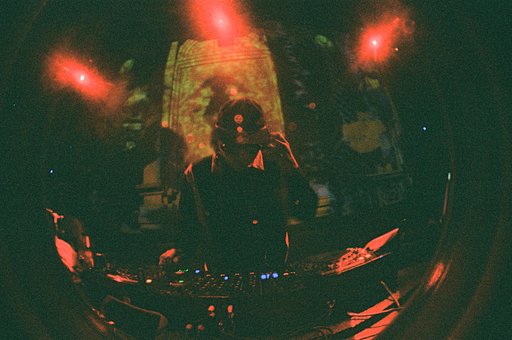
With its 170° lens mixed with features such as multiple exposure, bulb mode, and flash, the Fisheye No.2 is perfect for nights out. Here we share some tips on how to get the best low light photos with your Fisheye No.2.
Three Lenses in One – Nour Triplet v 2.0/64 Bokeh Control Art Lens

Ignite the legacy of a fascinating but forgotten scientist, Ibn al-Haytham, and become a master of light with this unique lens designed for spherical aberration control on full-frame mirrorless cameras. Shipping Live Now!
Available in our Shop
Enjoy Summer on Film with the LomoApparat Fluffy Omelet Special Edition

Thai artist Proei-Natchariya Laosrisin, also known as Fluffy Omelet, has designed a beach-themed new edition of our LomoApparat camera, perfect for capturing summer holidays on film. Check out the colorful camera and some photos taken by the artist!
Isabelle Baldwin's Large Format Experimentation with the LomoGraflok 4×5 Instant Back

Arizona-based photographer Isabelle Baldwin has a love for environmentalism and analogue photography, so when we found out that she takes her large format camera on her adventures, we knew she'd be the perfect match for our LomoGraflok 4×5 Instant Back.
The Fisheye No.2 and Double Exposure – A Multilayer Adventure

Make a bold statement and break from the straight lines of a classic lens. And if that is not enough, switch the multiple exposure feature on for an extraordinary circular adventure.
Bundle Up and Save!

On the look for a great deal? In need for the perfect gift? Not sure what film to get with your camera? Worry not and discover our budget friendly bundles including sweet discounts and freebies for many different products! Don´t miss a great deal and check them out now!
Jonathan Mok on His First Impressions of the Diana F+ and Love of 120 Film

Jonathan Mok is a California-based photographer and creator with a knack for medium format photography. We knew the Diana F+ camera would be a perfect photographic companion for him!
Charm Within Everyday Life – Anna Starr Shoots With the Diana F+

Anna Starr has a passion for medium format experimental cameras, so we knew she’d be a perfect match for our endlessly creative Diana F+. In these photos she brings attention to the little things we might miss when going about our daily lives.
Your Lomography Holiday Gift Guide 2023

Let's take a look back at Lomography's 10 Golden Rules and find out which gifts are perfect for you and your loved ones! Film, instant cameras, art lenses, scanning kits, cute gadgets. . . you're sure to find something that suits you!
Find Out More About


How To Use The Olympus Trip
April 28, 2023 By Cameras By Max
The Olympus Trip is a super popular camera among beginners to film, so here is our guide on how to use this awesome little camera, and some tips on how to get the most out of your Olympus Trip.
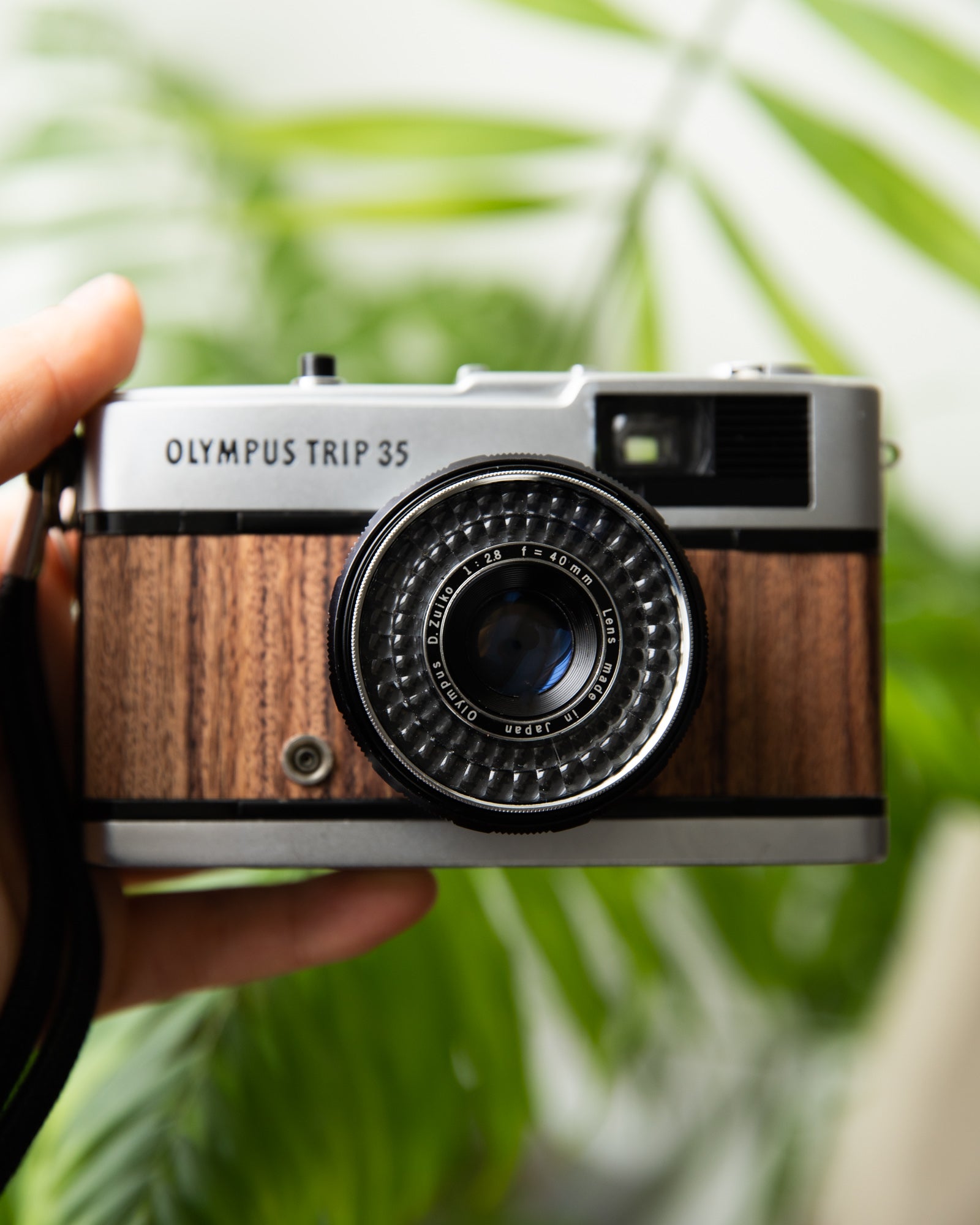
What is the Olympus Trip?
The Olympus Trip 35 was introduced in 1967, and discontinued in 1984, which is considered a long production run for a 35mm film camera. Over ten million Olympus Trip cameras were sold in this time.
Many people wrongly call the Olympus Trip a rangefinder camera, however we would classify it more as a point and shoot with zone focusing.
What features does the Olympus Trip have?
The Olympus Trip is really easy to use, and has some cool features that set it apart from other point and shoot 35mm film cameras.
- Zuiko coated 40mm f/2.8 lens : this lens is sharp, and the wide aperture makes it versatile in a lot of situations.
- Automatic settings : the Olympus Trip has two shutter speeds and aperture from f/2.8 to f/22.
- No batteries needed : the Olympus Trip is powered by the selenium meter around the lens. This is also what receives light and tells the camera which aperture is needed.
- Red flag feature : when the camera does not have enough light to take a photograph, a red flag appears in the viewfinder.
- Zone focusing : the Olympus Trip has four focus settings depending on how far away your subject is from the camera.

What are the different parts of the Olympus Trip?
The top plate.
The Olympus Trip top plate is very simple. The camera features are easy to find, making it an ideal camera for beginners. Below is a labelled diagram of the camera.
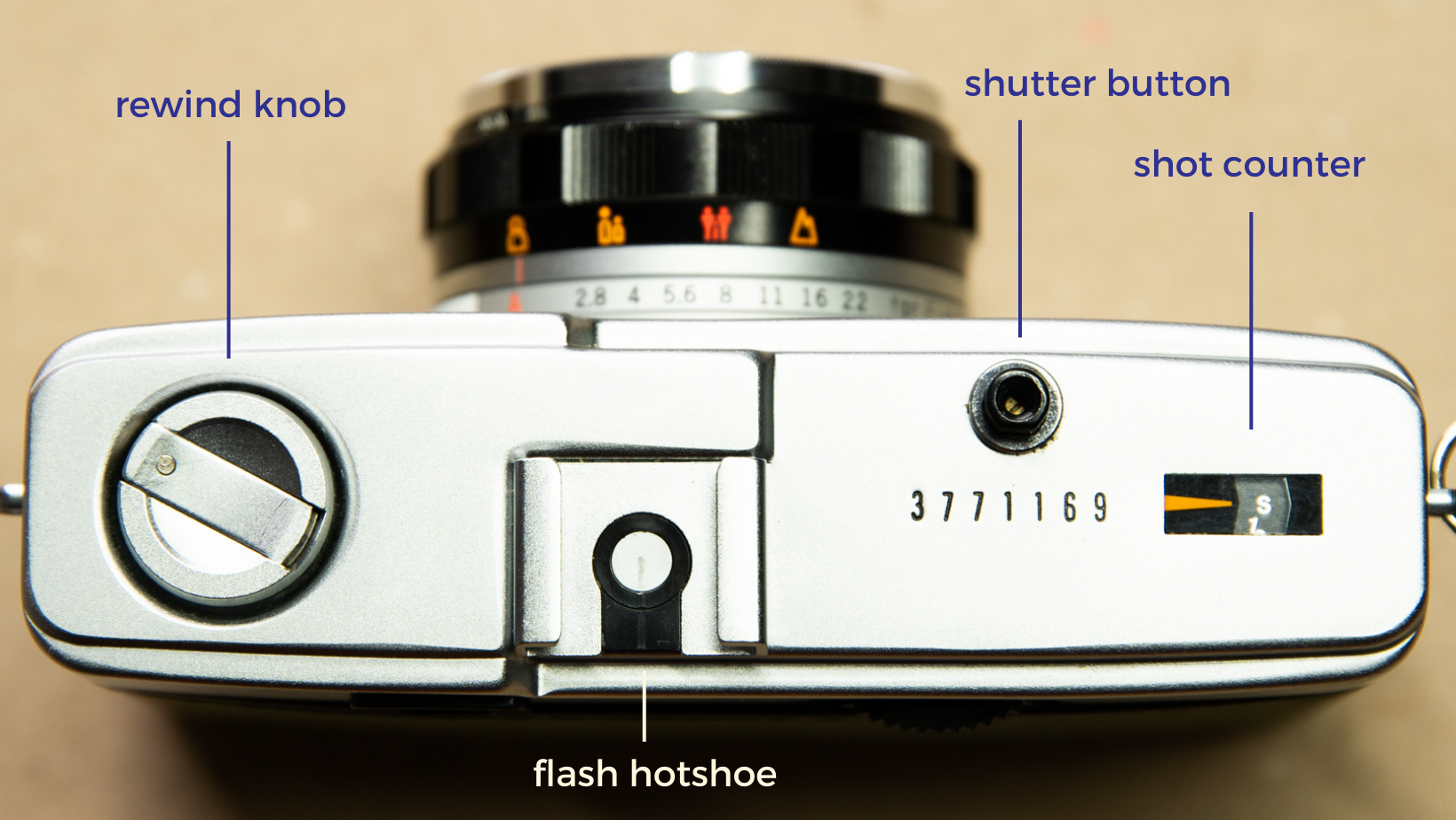
On the left of the top plate is the rewind knob (more on that later). In the middle is the flash hotshoe, used for mounting hotshoe flashes to the camera. The shutter button is the small black button on the top. On some models of Olympus Trip, this button can be silver. The small panel on the right is the shot counter that displays the number of shots you have taken.
The Olympus Trip lens holds most of the key settings for the camera , such as the ASA, focus, and aperture.

The ASA dial is set to match the roll of film that you put in the camera. For example, if you are using Portra 400, the ASA setting is set to 400.
The focus settings are simple, and known as zone focusing. There are four zones to choose from. We go through them in more depth later on in this article.
The aperture settings are only used if you are using flash. Otherwise, the camera is set to "A", which allows the camera to choose the aperture and shutter speed automatically.
The Bottom Plate
There is only one function on the bottom plate of the Olympus Trip 35: the rewind button. (And the tripod mount, technically.)

The rewind button is pressed when you are ready to start rewinding your film.
How To Load Film In The Olympus Trip
Loading film takes some practice, but it is really easy when you get to grips with it.
To load a roll of film in the Olympus Trip, first you have to open the back of the camera. To open the back of the camera, pull down this small silver tab, shown below.
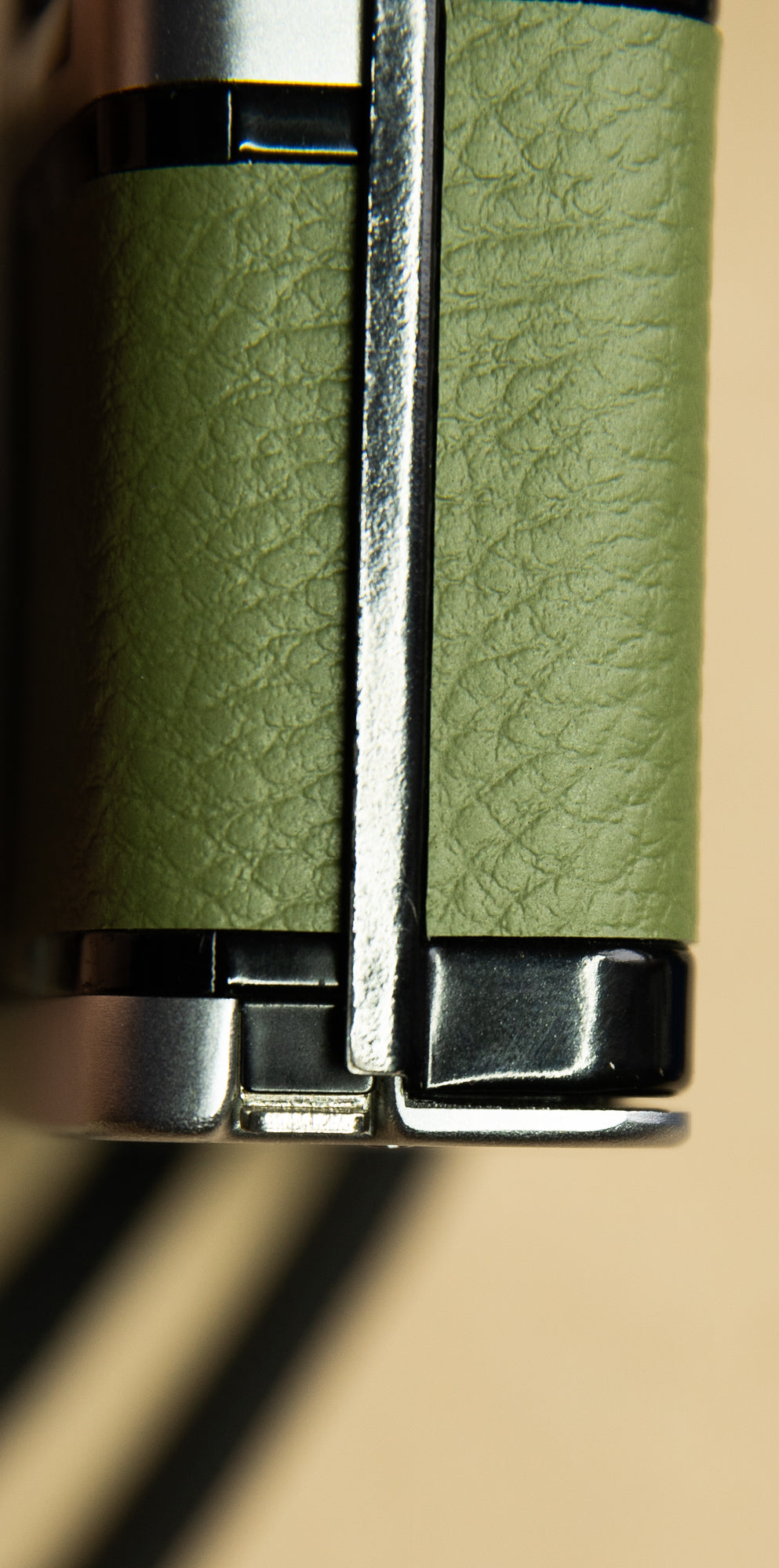
Once you have the back of the camera open, you can load your roll of film. To load the roll of film, pull the rewind knob up. The roll of film goes in with the top of the canister (the part that sticks out) at the bottom of the camera. See the image below.
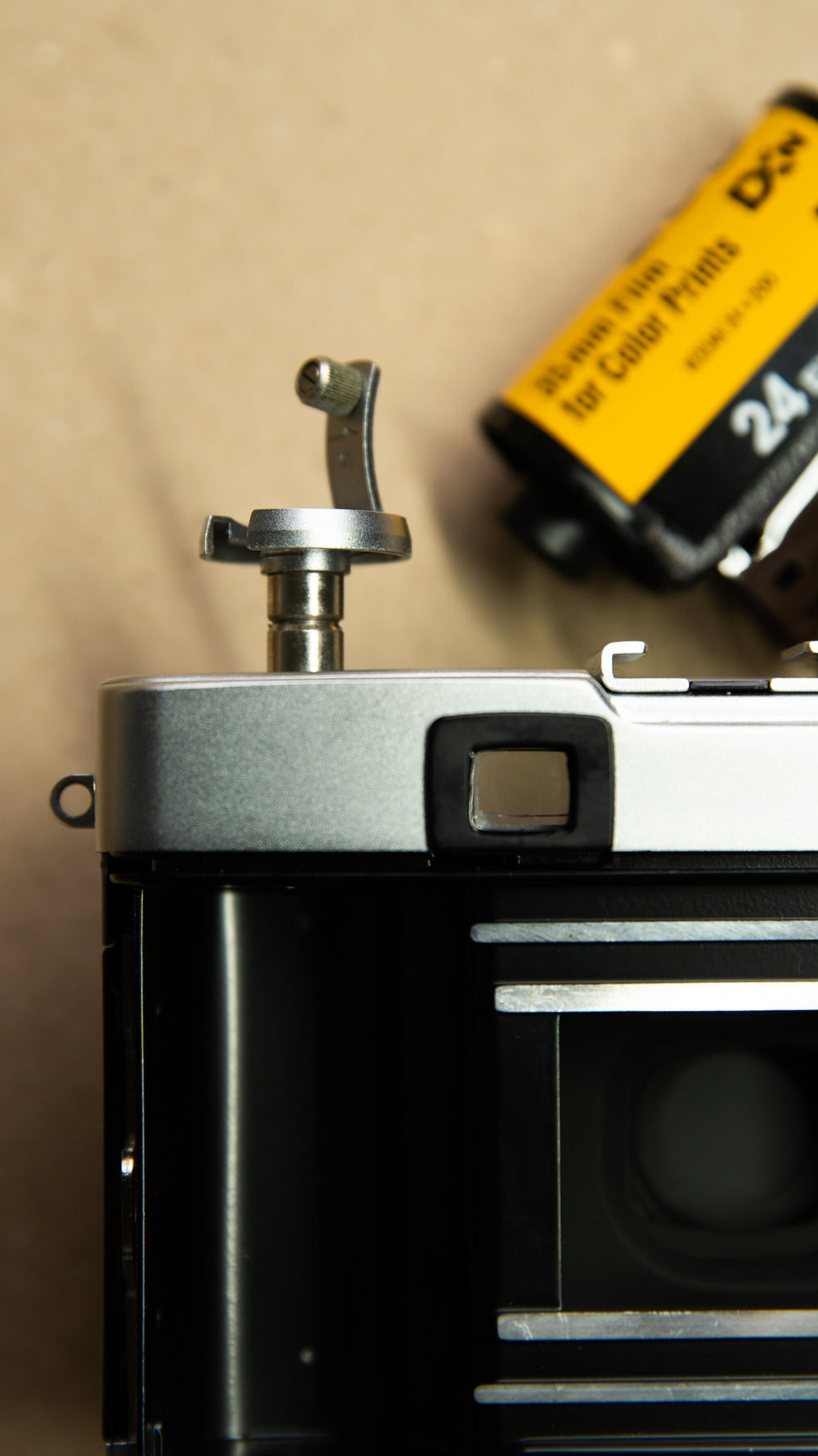
When the canister is in, as shown above, you can pull the film leader across the camera to reach the other side.
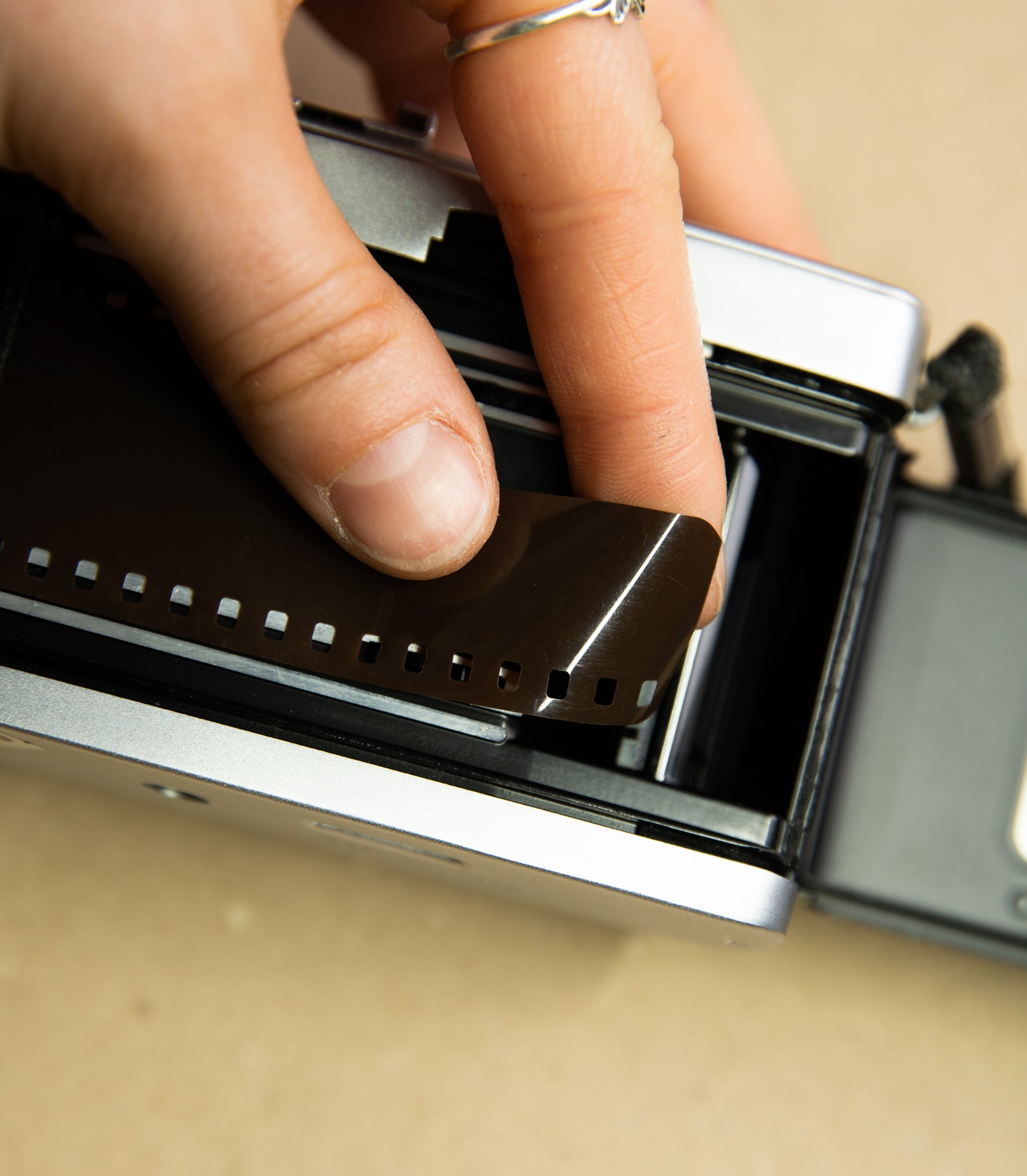
The rewind knob being put back down will lock the canister in place as you pull the film across. In order to lock the film onto the film spool in the camera, it has to go partly into one of the slots, and the notches at the bottom of the spool have to go through the sprockets on the film (the holes).
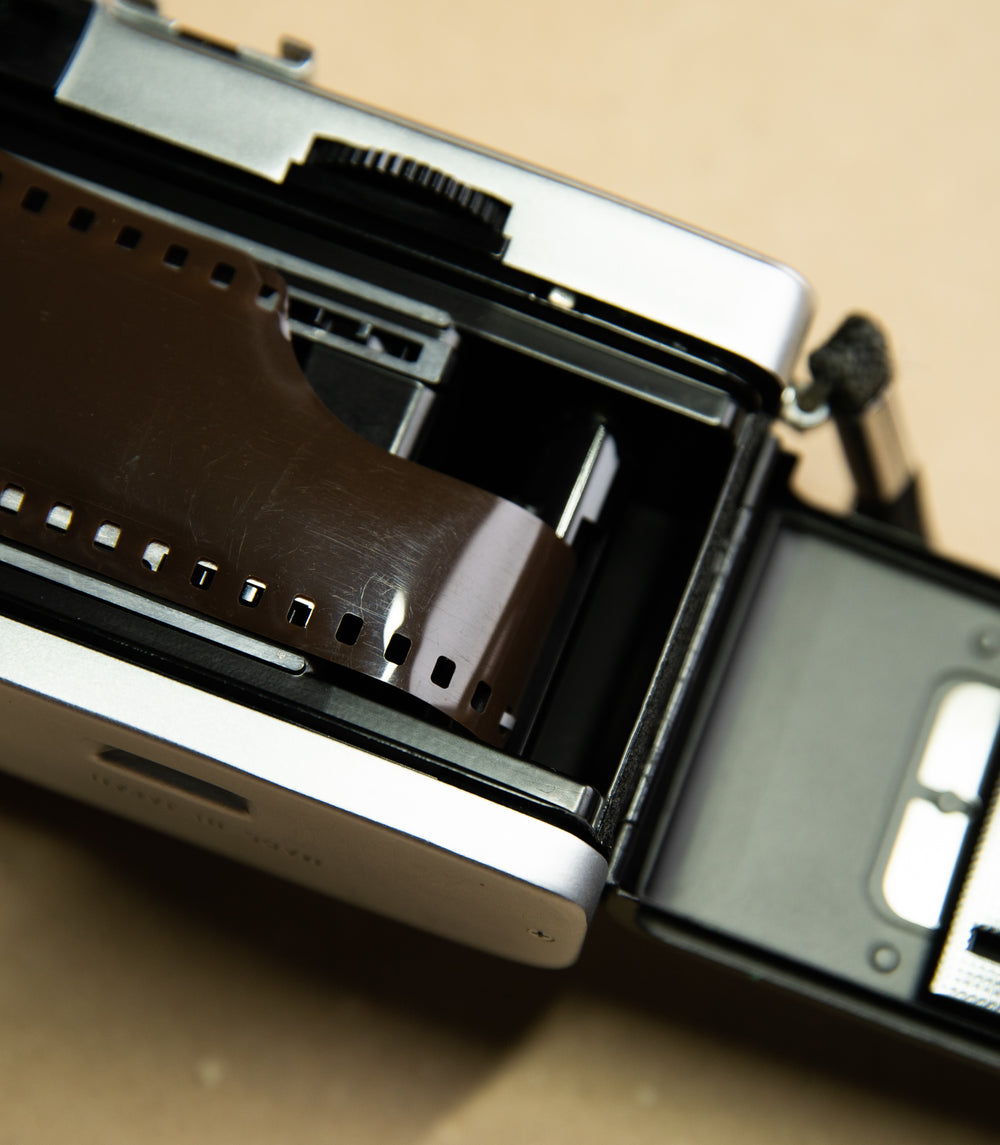
In order to be able to advance the film across the camera, you have to fire the shutter . You can do this by pointing it at a bright light or by setting the aperture setting to one of the numbers.
I recommend firing the shutter, and advancing the film (with the advance thumb wheel) twice before closing the back, so that you can make sure the film is definitely loaded correctly. As you get more confident, you can fire the shutter less times and therefore get more photos on your roll of film.
How To Take Photos With The Olympus Trip
Now you have loaded your roll of film, and closed the back of the camera, you are ready to start taking photos!
The first thing to check is that your ASA is set to the same speed as your roll of film. For example, Portra 400 is ASA 400. Or Kodak Gold is ASA 200.

When looking through the viewfinder, you will be able to see your frame lines, and the focus setting that the camera is set to. The viewfinder of the Olympus Trip does not show you where the focus is set, just which symbol you have the lens set to.
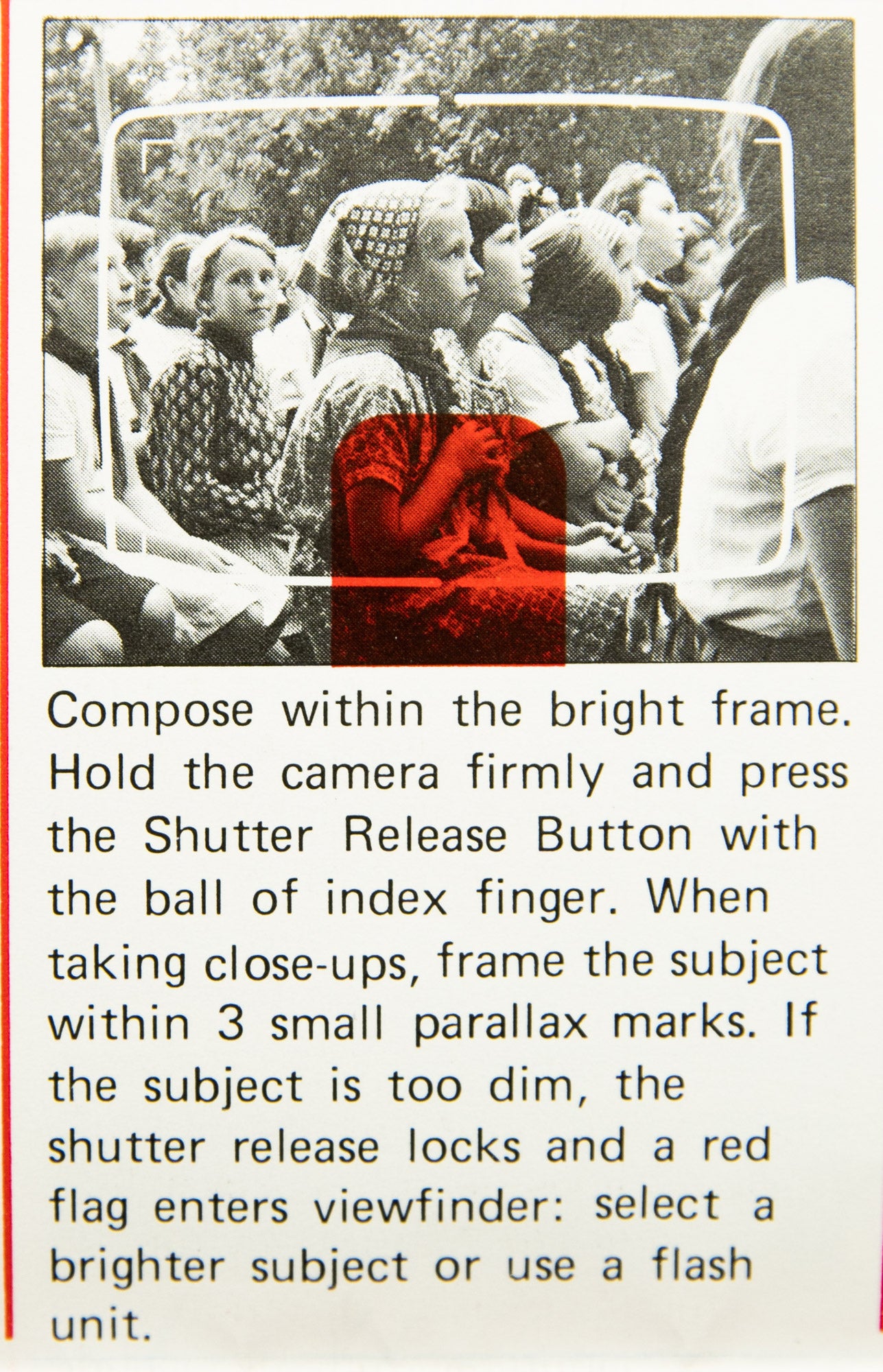
When the lens is set to "A", the camera will choose the shutter speed and aperture for you manually. If the image you are trying to take is too dark, the red flag will come up.
You can override this by setting it to one of the numbers instead, but be aware that these are intended for a flash to be used with it. By setting the Olympus Trip to a number on the lens, it reduces the shutter speed to 1/30 - that's one thirtieth of a second. So you will need to have a steady hand when doing so.
How does the film counter on the Olympus Trip work?
When you first load your roll of film, it may look as though the film counter is not moving. It takes two or three shots for the shot counter to move to the number one.
The back of the camera needs to be closed in order for the shot counter to start working.
The counter shows the amount of images you have taken, not how many you have left.
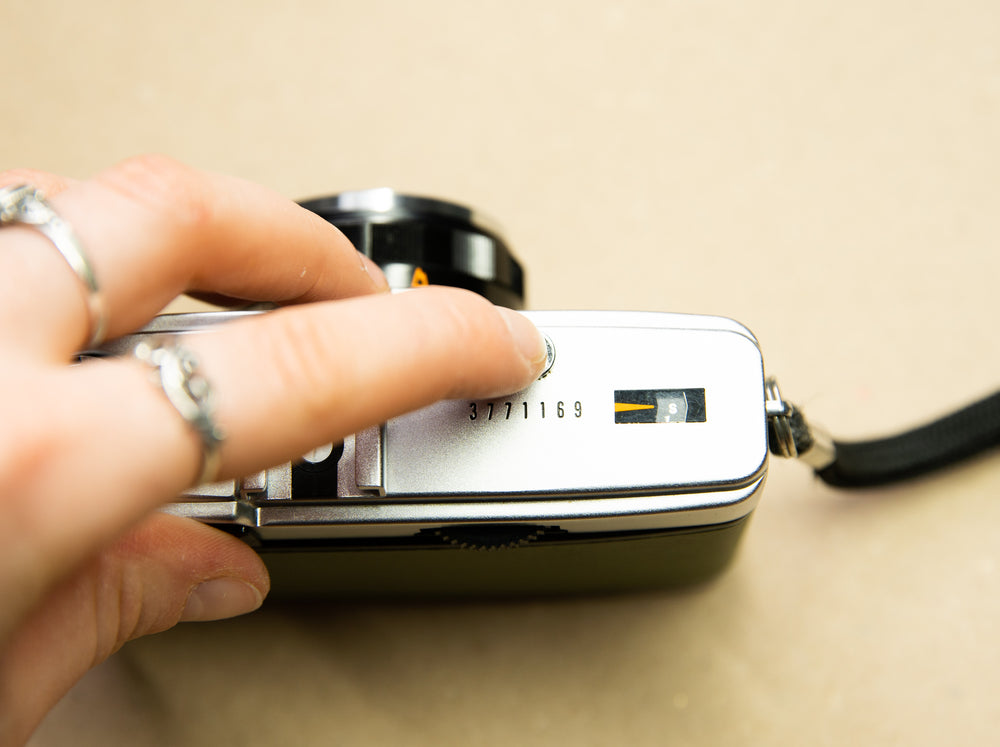
How do I focus the Olympus Trip 35?
The Olympus Trip focus settings are simple, but take some getting used to. There are four settings on the camera. The symbols for these are found on the black part of the lens, as shown earlier in the article.
The symbols are as follows:

The Olympus Trip has four focus settings . The viewfinder view does not change as you change the focus settings, so you need to know which setting is correct for how far away your subject is. Luckily, this is not hard.
The first setting has the symbol of one person. The first setting is used for close-up photographs , where the subject is less than 1 metre away.
The second setting is of two people, which is to be used for subjects from 1.5 to 3 metres away.
The third setting is a symbol of three people. This setting is used for subjects that are between 3 and 6 metres away.
The final setting is a symbol of a mountain, which is used for anything beyond 6 metres away.
If you ever forget these numbers, they are engraved on the underside of the lens (opposite to the symbols on the top).
How does the Olympus Trip 35 red flag feature work?
The purpose of this Olympus Trip feature is to stop you from taking a photograph that is not exposed enough and therefore will not be visible when developed.
When there is not enough light in your image, the red flag will pop up in the viewfinder. You will clearly be able to see it if you are looking through the viewfinder. It also blocks the shutter button from being pressed.
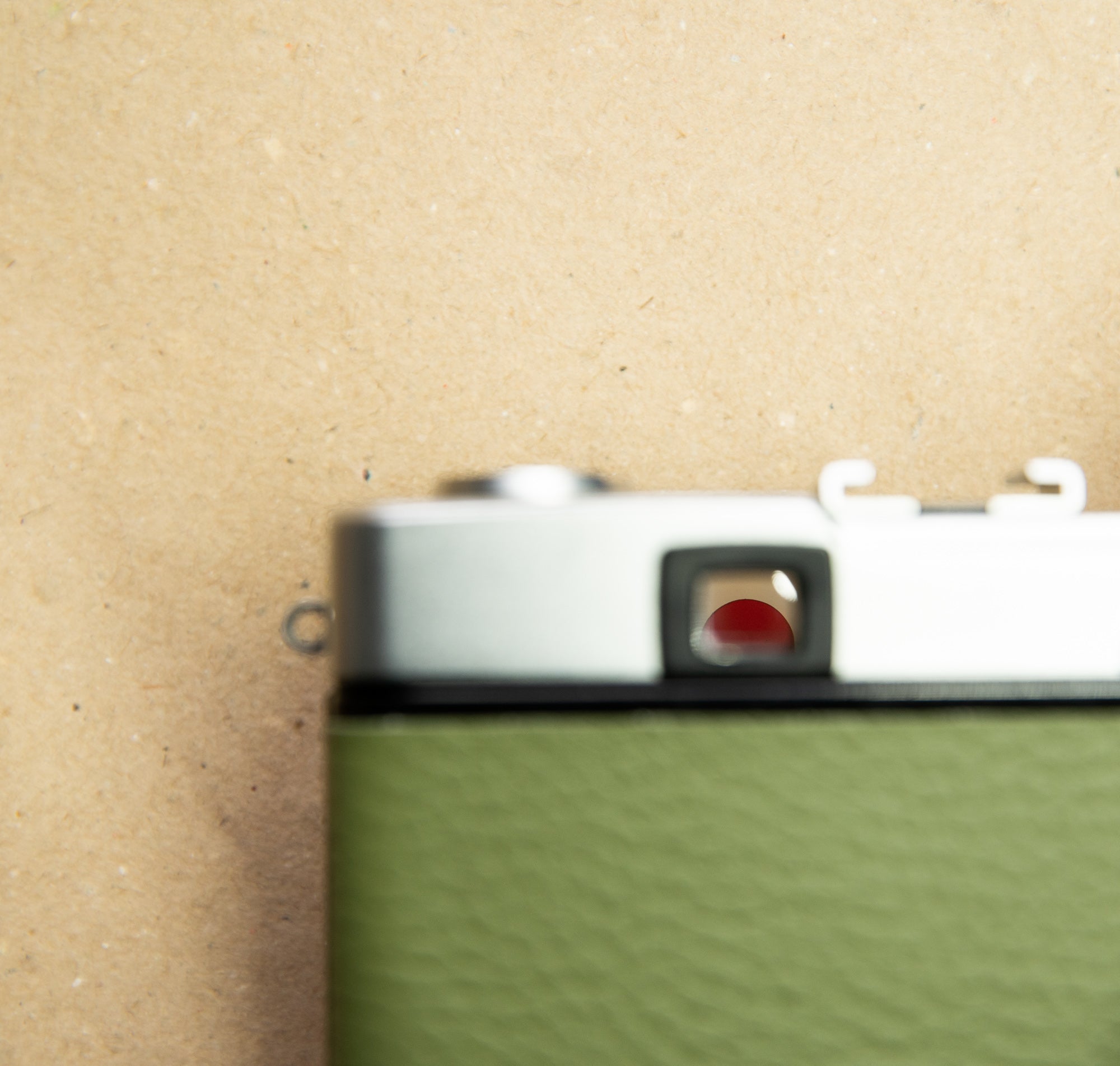
Can I use the Olympus Trip at night?
Yes, you can.
The easiest way to do this is to attach a flash to the top of the camera.
Attaching a flash to the top of the camera is easy and most flashes can be used on the Olympus Trip. It has a standard flash hotshoe on the top of the camera.
Here is an example of a flash that can be used on the Olympus Trip:
When using a flash on the Olympus Trip, there are different settings to use. These are the aperture numbers on the silver barrel of the lens closest to the camera.
The aperture you use needs to be read off of the meter table, which is usually displayed on the back of the flash unit.

You can read more about using the Olympus Trip at night here .
How To Rewind Your Film
Congratulations, you've finished your roll of film.
How can I tell if the roll of film is finished?
You will start to feel some resistance when trying to advance the camera. Do not force it, as you will snap part of the mechanism.
If you are using a 24 exposure roll of film, you will have reached the 24th shot. The shot counter should show the number 24, or near to that number. The same applies for a 36 exposure roll of film, as this will show the number 36. Sometimes you are lucky and get 37 or 38 shots out of a roll of film.
When the film will not advance any more, the film is finished.
How do I take the roll of film out?
On the bottom of the camera is your rewind button. Push this button in. It should stay in after you have pressed it once.
You can now use the rewind knob to rewind the film into the canister. Turn the knob clockwise.

Rewinding the film usually takes around thirty seconds of rewinding. You will feel when the film comes off of the spool at the end, because the rewind knob will have less resistance. Keep rewinding it until you feel certain that the film is back inside the canister.
You can now open the back and take the film out.
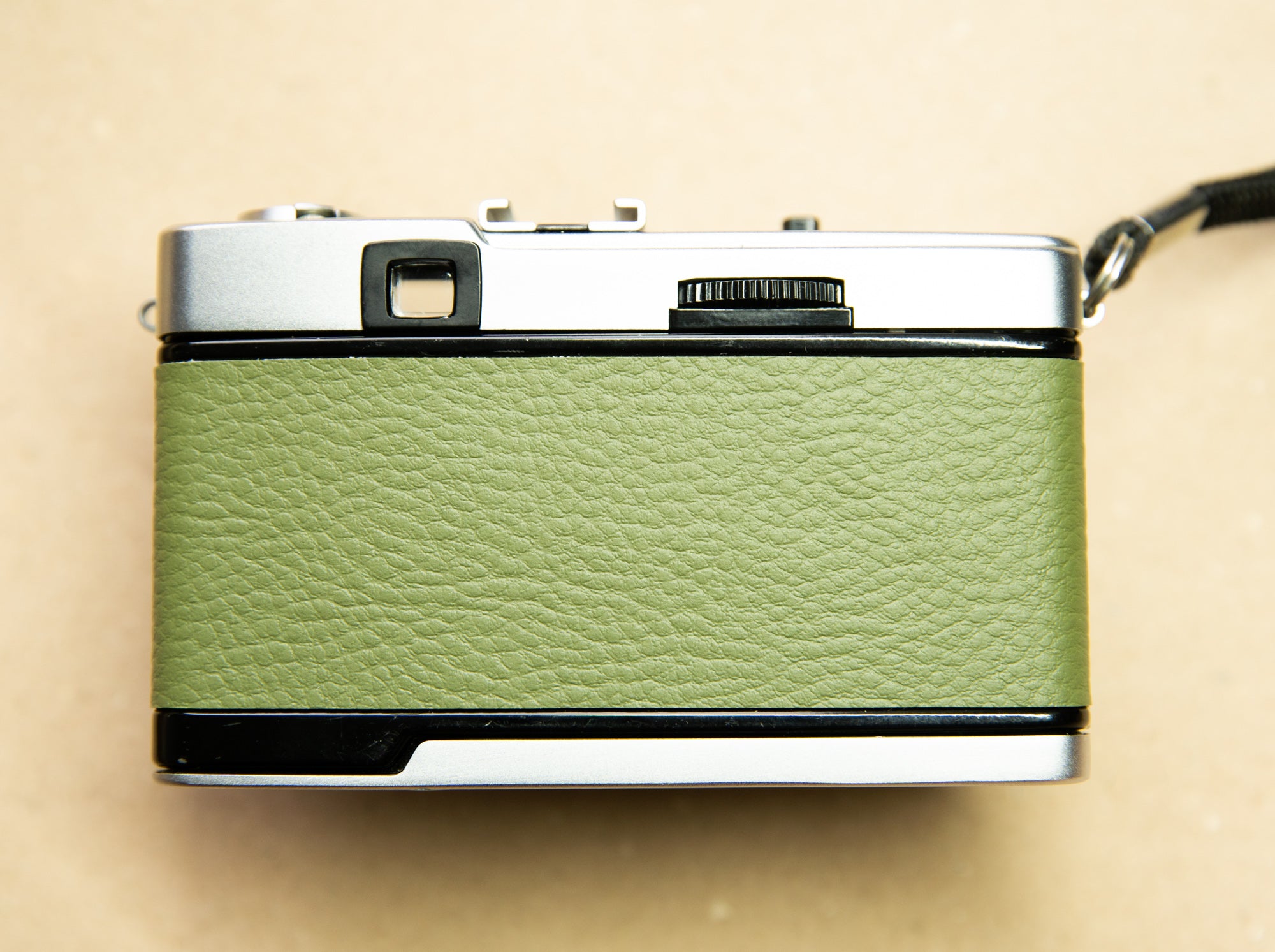
That's just about everything you need to know about the Olympus Trip 35 35mm film camera! We really recommend this camera for beginners, so we hope you have a great time using it and create some lovely images.
I think my Olympus Trip is broken; what should I do?
A lot of Olympus Trip 35mm film cameras have never been serviced in their lifetime. Because they are holiday cameras, a lot of them have sand in the mechanisms.
We highly recommend getting your Olympus Trip serviced if it hasn't been used in a while.
Maintained, these cameras can last many years, however when they have been left for decades, they can develop a few issues, such as stuck aperture blades, stuck shutter, non-functioning light meter, etc.
All of our Olympus Trip services and repairs are very affordable, so definitely consider sending it to us before deciding that it doesn't work, or putting it back in a drawer.
Shop our full range of Olympus Trips and accessories here:
Find out more about the olympus trip here:.

Featured Camera: The Olympus Trip 35

Can You Use the Olympus Trip At Night?
If you like what we do, but can't buy a camera from us, please consider buying us a cup of coffee! It helps us to keep these resources free, consistent, and accessible.
Still stuck on which film camera to buy?
Try our film camera quiz. All you have to do is answer a few questions, and then you will get a list of personalised camera recommendations.
Or send us a message on Instagram , send us an email , chat to us on our live website chat, or read some more of our blog posts!

Article written by: Max
Max is the owner of Cameras By Max. They work full-time repairing and refurbishing all the 35mm film cameras you see on the website. Their favourite camera (at the moment) is the Olympus XA, and their favourite city in the world is Edinburgh.
Take our quiz to find your perfect film camera.
Not sure which camera is best for you?
Congratulations! Your order qualifies for a free planted tree. Plant a tree with any order over £60!
No more products available for purchase
Your cart is currently empty.
🚨 RCF is currently away from the workshop on holiday until the 18th May - all orders placed until then will only be processed after this date!

Item added to your cart
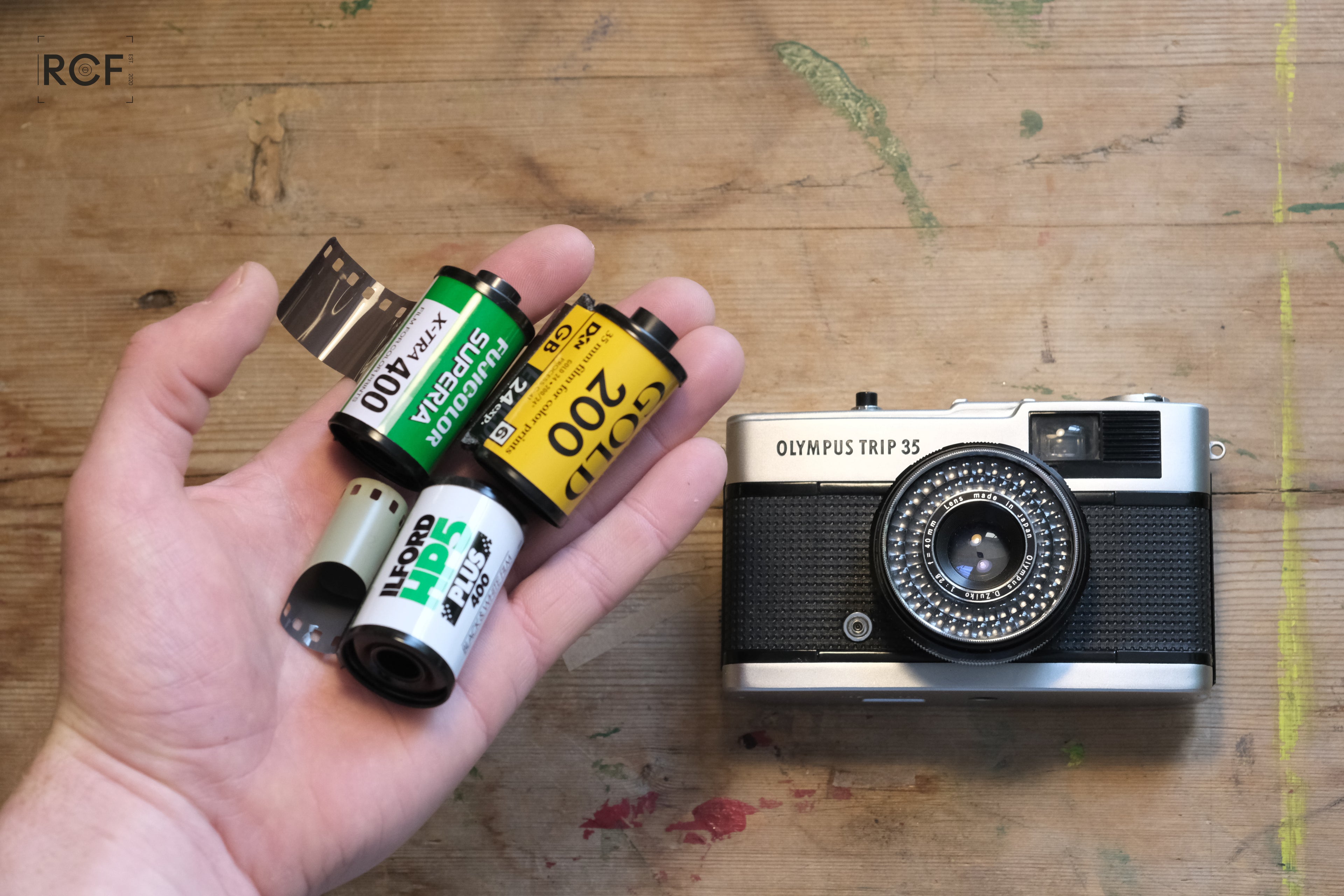
If you're the proud new owner of a vintage Olympus Trip 35 film camera, you're in for a treat! This classic piece of photographic history is perfect for capturing memories with a unique analog touch with ease. In this guide, I'll walk you through the step-by-step process of using your Olympus Trip 35, complete with images and important precautions to ensure you get it right every time.
Expand the relevant guide:
Collapsible content
Loading film into the olympus trip 35:.
Step 1: Choose your film
Select your preferred 35mm film roll, keeping in mind that the Olympus Trip 35 is compatible with ASA/ISO speeds ranging from 25 to 400.

Popular film brands include Kodak, Fujifilm, and Ilford. This post I wrote might be useful: Buying 35mm Film - A Complete Guide
Step 2: Set the film speed and set the camera to manual for film loading
Set the appropriate ASA/ISO speed for your film using the dial located on the front of the camera, near the lens.

Also turn the aperture ring to any manual f number against the red line so that it isn't set to 'A'. The shutter can now be released regardless of light conditions.
Step 3: Open the camera back
![olympus trip 35 info [Image 2: The Olympus Trip 35's back lock tab]](https://cdn.shopify.com/s/files/1/0571/3212/2301/files/DSCF2797_480x480.jpg?v=1684491064)
Locate the back cover lock tab on the bottom of your Olympus Trip 35. Pull it down and the camera back should pop open.
Step 4: Insert the film cartridge
![olympus trip 35 info [Image 3: Film cartridge being inserted into the camera]](https://cdn.shopify.com/s/files/1/0571/3212/2301/files/DSCF2798_480x480.jpg?v=1684491072)
Lift up the rewind knob and insert the film cartridge into the film chamber on the left side of the camera, making sure the tip of the film is pointing toward the take-up spool on the right side. Then push the rewind knob back down into the roll of film (sometimes needs a wiggle or slight rotation to go all the way back down).
Step 5: Engage the film leader into the take-up spool
![olympus trip 35 info [Image 4: Film leader inserted into the take-up spool]](https://cdn.shopify.com/s/files/1/0571/3212/2301/files/DSCF2800_480x480.jpg?v=1684491080)
Pull the film across the camera and insert the tip securely through and into a slot on the take-up spool. Advance the film using the wind-on wheel.
Step 6: Align the film perforations
Ensure that the film perforations are aligned with the sprocket teeth on both sides of the film.
![olympus trip 35 info [Image 4: Film leader inserted into the take-up spool]](https://cdn.shopify.com/s/files/1/0571/3212/2301/files/DSCF2801_480x480.jpg?v=1684491091)
This ensures the film will advance smoothly when winding.
Step 7: Close the camera back
Close the camera back tightly. The camera back should click shut, indicating it is securely closed.
![olympus trip 35 info [Image 6: Closing the camera back]](https://cdn.shopify.com/s/files/1/0571/3212/2301/files/DSCF2803_480x480.jpg?v=1684491101)
IMPORTANT: Never open the camera back before fully rewinding the film, as this can expose your film to light and ruin your photos. Make sure to rewind the film completely after taking all 24 or 36 frames before unloading it.
Step 8: Advance film to '1'
Keep winding film and releasing the shutter until the film counter points to "1". This ensures the unexposed part of the film is ready for your first photo.

IMPORTANT: Watch the rewind knob when you wind the camera on ; it should start to rotate at the same time as you wind, indicating that the film has been taken up correctly - this is key, if this is not happening after a few shots then it probably means that the film has not been securely engaged by the take-up spool and the loading process will need to be repeated.

Step 9: Set the camera back to "Automatic" and get ready to shoot!
Turn the aperture ring until the 'A' mark is aligned with the red line in front of the viewfinder (click stop).

Your Olympus Trip 35 is now loaded with film and ready to capture amazing photos.

Taking Photos with the Olympus Trip 35:
How to take photos with the olympus trip 35:.
Step 1: Ensure the camera is wound on
This gets the shutter ready and primed to take a photo.
Step 2: Set subject zone focus distance on the lens
The Olympus Trip 35 has 4 settings which equate to focusing zone distances away from the camera (shown on the underside of the lens barrel):

- 🧍♀️Close focus ≈ 1 meter. This setting is used for focusing on anything ~1 meter away from the camera, be it close headshots or other close up details.
- 👥 Portrait ≈ 1.5 meters. Used for focusing on anything ~1.5 meters away from the camera, for example portraits or capturing wider details in the photo.
- 👯 Group ≈ 3 meters. Focusing on anything ~3 meters away from the camera, eg. full length body shots/group photos.
- 🌄 Scenery ≈ 5+ meters. Focusing on everything 5+ meters away from the camera, great for landscapes or subjects far away from the camera!
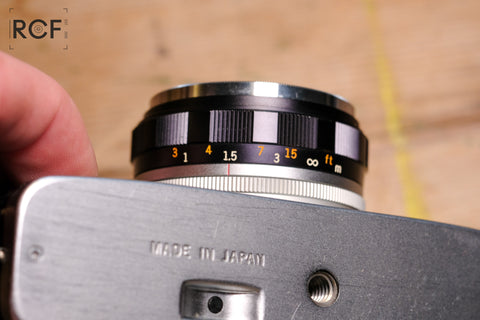
Step 3: Ensure aperture ring is set to 'A'
For 99% of situations in good light without a flash, it's best to leave the camera set to the red 'A'.

This lets the camera's solar powered meter set the exposure settings automatically and ensures a good exposure.
Step 4: Compose the photo using the viewfinder

Use the projected frame lines to see the area that will be captured in your photograph. There are hash marks to indicate the change in frame at close focus.
Step 5: Take photo by pressing shutter button

There should be a small click as the shutter fires - indicating a photo has been taken! 🙌 If instead a red flag appears in the viewfinder, this is a warning that there is not enough light in the scene for a proper exposure.

You can manually disable the red flag low light warning and take a photo anyway in low light by setting the aperture to '2.8'.
Towards the end of the roll it is important to not try to wind on the camera hard when you start feeling quite a lot of resistance or cannot wind on further - this signifies that the roll is finished, but if pushed too hard at this stage can result in the film snapping in the back of the camera.
Unloading Film from the Olympus Trip 35:
Step 1: Check the film counter
Once you've taken all the photos on your film roll (either 24 or 36 frames), check the film counter to ensure you've reached the end.
![olympus trip 35 info [Image 10: Film counter indicating the last frame]](https://cdn.shopify.com/s/files/1/0571/3212/2301/files/DSCF2809_480x480.jpg?v=1684491137)
Towards the end of the roll it is important to not try to wind on the camera hard when you start feeling quite a lot of resistance - this signifies that the roll is finished and if pushed too hard can sometimes result in the film snapping in the back of the camera.
Step 2: Press rewind button in

Find the small black button on the base of the camera and push it in to disengage the film from the winding mechanism and allow the film to wind back into the film canister inside the camera.
Step 3: Rewind the film
Press the rewind button located on the bottom of your Olympus Trip 35. Then, turn the rewind knob clockwise to rewind the film back into the cartridge. Keep rewinding until you feel the tension release, indicating that the film has been fully rewound.
Step 4: Open the camera back

Following the same steps as when loading the film, locate the camera back lock tab on the bottom of your Olympus Trip 35. Pull it outwards to open the camera back.
Step 5: Remove the film cartridge
![olympus trip 35 info [Image 13: Film cartridge being removed from the camera]](https://cdn.shopify.com/s/files/1/0571/3212/2301/files/DSCF2813_480x480.jpg?v=1684491173)
Pull up the rewind lever and lift the film cartridge out of the film chamber.
Step 6: Store and develop your film
![olympus trip 35 info [Image 14: Film cartridge ready for storage or development]](https://cdn.shopify.com/s/files/1/0571/3212/2301/files/DSCF2814_480x480.jpg?v=1684491181)
Place the film cartridge in a light-tight container to protect it from light exposure. Take or send your film to a lab for development or develop it yourself using the appropriate chemicals and techniques.
Shop The Olympus Trip 35
Olympus trip 35 vintage 35mm film camera | tested & fully refurbished | 100 day guarantee, olympus trip 35 vintage 35mm film camera - forest slate green | tested & fully refurbished | 100 day guarantee, olympus trip 35 vintage 35mm film camera - burnt orange | tested & fully refurbished | 100 day guarantee, olympus trip 35 vintage 35mm film camera - golden yellow | tested & fully refurbished | 100 day guarantee, olympus trip 35 vintage 35mm film camera - teal green | tested & fully refurbished | 100 day guarantee, olympus trip 35 vintage 35mm film camera - royal blue | tested & fully refurbished | 100 day guarantee, olympus trip 35 vintage 35mm film camera - lipstick pink | tested & fully refurbished | 100 day guarantee, olympus trip 35 vintage 35mm film camera - sand beige | tested & fully refurbished | 100 day guarantee.
- Choosing a selection results in a full page refresh.
- Opens in a new window.

- Camera Reviews
- Lens Reviews
- The CCD Sensor
- Mobile Photography
- Half Frames
- MarketPlace
Search ImagingPixel for Images by Camera or Lens
Olympus trip 35 35mm zone-focus film camera.

T alk about the essence of 'iconic' 35mm compact cameras of yesteryears, cameras that help bring photography to the masses, cameras that are as equally functional as it is easy to use, cameras that are automatic but do not require a battery to operate, cameras with super sharp f/2.8 lenses, and the Olympus Trip 35 is always the one camera that will come to mind.
The Olympus Trip 35 , a fully automatic viewfinder camera, is a point-and-shoot 35mm compact model manufactured by Olympus. It was introduced to the market in 1967 as a compact, functional camera for holidays, went on to become very popular among the masses, and sales ended in 1984 after a prolonged production run, with over ten million units sold.
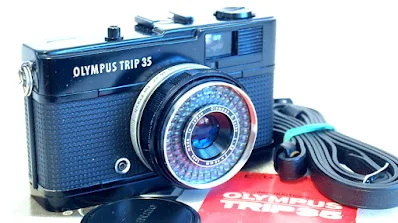
The camera is fitted with a coated non-interchangeable 40mm f/2.8 D. Zuiko lens, acknowledged as being very sharp and capable of capturing high-quality images, and operates as a programmed automatic with only two shutter speeds, at 1/40th sec or 1/200th sec. at apertures of between f/2.8 to f/22.
SCL Photography Guide: The Olympus Trip 35 Film Camera A fresh look at an old classic, to get you shooting your old Trip 35 or perhaps to interest you in investing in this great little film camera. Includes guide to buying, checking, loading and shooting with the camera. Bonus flash guide at the end. Thanks, Rob.
A low-light lock, with a red flag indicator, prevents you from taking under-exposed shots or trying it with the lens cap on.
Production Models
The design of the camera is simplicity itself. Early production units of the Trip 35 are manufactured with a silver shutter release button, with a film ISO speed rating from 25 to 200. Later production units, manufactured after 1978, come with a black plastic shutter release and a higher film ISO speed rating of 25 to 400. The Trip 35 is also available in black, which is much sought after by collectors.

The lens and lens mount are located centrally on the front of the camera, with a viewfinder window on the right front of the top plate, and a flash sync socket on the lower left of the lens mount.
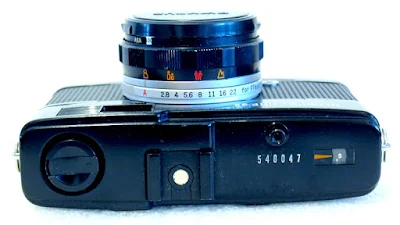
On the top plate are the rewind crank, housed in a nice recessed on the left of the top plate, the accessory shoe (located slightly off-center), the shutter release button, and on the right, the frame counter.

The Trip 35 comes with a plain film back, with only the viewfinder eyepiece and film forward wind at the back of the top plate. The hinge-type film back is opened by pulling down on a latch lever lock located on the film chamber side of the film box.

The bottom plate carries the tripod socket and the rewind release button.

The film box is Olympus easy-load type, with the film chamber, shutter frame window, film guide sprocket, and a multi-slot takeup spool laid sequentially from left to right. Film loading is the normal 2-blank shot to forward the film to frame 1.
Year of Production
If you are interested in knowing when your camera was produced, you need to open the film compartment, remove the pressure plate on the back of the door by sliding it free from its locating pins, and look for the 3-character manufacturer's code on the back of the pressure plate.
- The 1st character or letter (in later models) signifies the assembly plant.
- The 2nd number represents the last digit of the year of assembly, e.g. 6 = 1976, 0 = 1980
- The 3rd number or letter represents the month of assembly, 1-9 for Jan-Sep, X, Y, and Z for Oct-Dec.
For example: If the code reads N2Y, then the production was in November 1972
Viewfinder Readout
The viewfinder is an albada-type bright frame, with frame lines and parallax markings for closer focusing.

There is a second, very small window under this, nicknamed the "Judas window", which shows the current aperture setting and distance symbol which are on the lens barrel.
A small red flag will appear in the viewfinder if the auto-exposure mechanism decides there is not enough light and refuses to fire.
Film ISO Speed
The camera will accept films with an ISO speed, for later models, of 25–400. Earlier models, from the first few years of production, had a maximum ISO speed of 200. A hot shoe and a Prontor-Compur sync connector provide for flash photography.
Zone Focusing
The Olympus Trip 35 focuses manually with a simple four-position zone-focus system, with distance settings displayed on the top scale in graphic form, and a bottom scale calibrated in both meters and feet. Focusing distances are 1 meter, 1.5 meters, 3 meters, and infinity.

Shutter Speeds
In Auto Mode, the shutter speed is set to 1/200th sec, and exposure is automatically controlled by aperture opening, whilst in manual or flash sync mode, the shutter is set to 1/40th sec, and a range of aperture openings from f2.8 to f22 can be selected for the shot.
Battery Not Included
The Olympus Trip 35 is built with a solar-powered selenium light meter, and it does not need any battery for it to run and operate. It is ideal for both the new user just getting into photography or the seasoned operator who wants slightly better control over the aperture setting and zone focusing mode. An accessory shoe and flash sync connector provide for flash photography.
Using The Camera
As with a fully automatic point-and-shoot camera, be it a film or digital, the Olympus Trip 35 is easy and fun to use.

Aside from the need for a roll of film to be loaded into the camera, be sure to set the correct film speed (ASA) setting, by turning the ASA ring in front of the lens barrel so that the ASA speed is displayed in the small opening.
Set the aperture or F-stop ring to 'A' for Auto, and off you go.
For the zone-focusing part of the equation, give it a go at estimating the distance of your subject, or turn the focal ring graphic icons to match the subject of your composition, be a portrait or head-shoulder shot, a three-quarter height shot, a group shop or just a view of the land, sea or urbanscape.
Early Images
A friendly shop assistant showed off his antics.

Do remember to check the zone focus setting as you go on with your shooting assignment. On bright and clear days the 40mm f/2.8 lens can be very forgiving and will stay sharp most of the time, but when things get a little dark and the automatic aperture falls to below f/5.6 you will tend to get blurred images if the zone focusing distance is not just right.
Olympus Trip 35 Instructions: Click here to download from www.buktus.org
Vintage Camera Marketplace by ImagingPixel
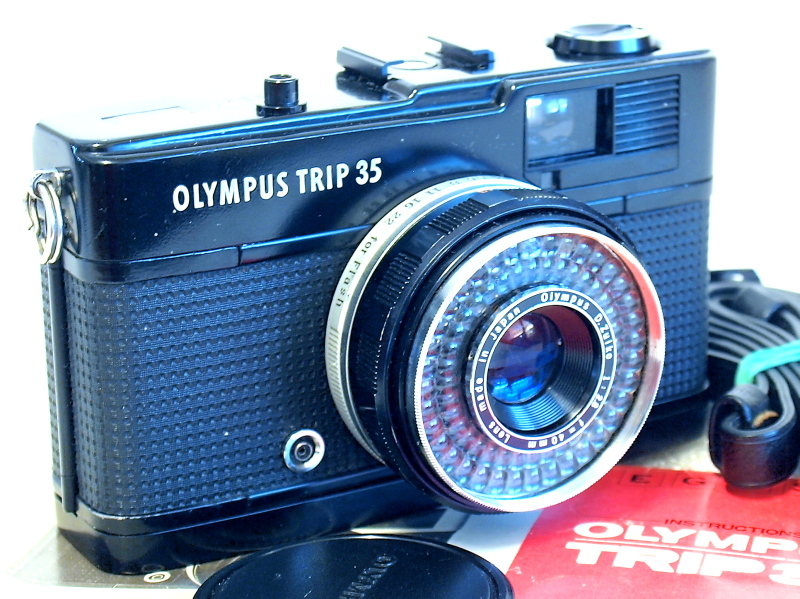
4 comments:

She is nice in black, too, but I like the silver/black better ;-)

Others may not agree with you, but I do believe that the current film camera enthusiasts are more inclined toward the silver/blacks... thanks
Hey thanks for the article. You state that in Auto mode the shutter speed is set at 1/200 and with flash it's 1/40. In fact both shutter speeds are available in auto and it switches at a point around EV 12.5 from f11 1/40 to f5.6 1/200, depending on the available light. It'll shoot down to EV 8.5: 1/40 2.8 and almost up to EV 17: 1/200 f22 in auto mode. The available combinations are 1/40 f2.8-f11 and 1/200 f5.6-f22 and it looks to actually select third-stops across this range, or thereabouts. This can be seen by the needle trap mechanism - there is an armature to determine the shutter speed by how far the armature raises when the shutter is depressed; this engages at one of two different cutout heights with the meter needle (along with a corresponding stepped scale for aperture), depending how far the needle is deflected by the coil/selenium cell circuit. It's an ingeniously simple mechanism - and worth noting that even in the daylight, on a dull overcast day, your shutter speeds can easily be low enough to blur if you don't make an effort to steady the camera.
Thanks for the followup, great!
Popular on ImagingPixel

Browse Over 250+ Film Cameras Shop Now
Trusted By Over 30,000 Customers On Their Photography Journey Early Access
Free Worldwide Shipping on Orders Over £200 Learn more
- Russia (GBP £)
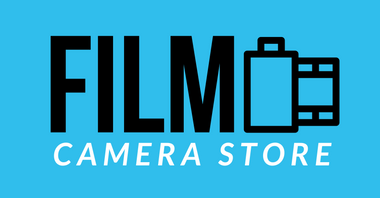
Returns & Exchanges
Hassle Free Returns Policy
Free Tracked UK Delivery
Tracked & Next Day Delivery
30 Days Guarantee
Market Leading Assurance
Free Worldwide Shipping
On All Camera Orders
-WE ARE CLOSED 15th,16th,17th of may-
Orders made within these dates will be dispatched the following week. order before 12pm 14th of may to receive your order whilst we are closed.
Why the Olympus Trip 35 is a Classic Camera Worth Owning
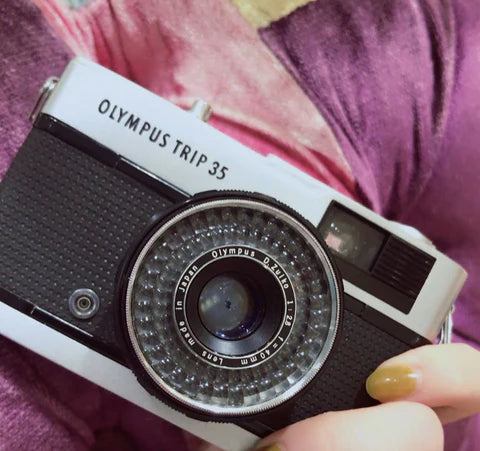
David Johnson | April 14, 2023

History of the Olympus Trip 35
Design and build quality.

Zone Focusing
Light metering, easy to use.

Affordable Price
Shooting experience.

Film Availability
Repairs and maintenance.
- Tweet on Twitter
- Share on Facebook
- Pin on Pinterest
Previous Next
Your cart is empty
Subtotal: £0.00 GBP
Free Delivery Service
UK & Worldwide Delivery
Reliable Delivery
Hassle Free Returns
Choose options

- Electronics
- Camera & Photo
- Film Photography
- Film Cameras
- Point & Shoot Film Cameras
Fulfillment by Amazon (FBA) is a service we offer sellers that lets them store their products in Amazon's fulfillment centers, and we directly pack, ship, and provide customer service for these products. Something we hope you'll especially enjoy: FBA items qualify for FREE Shipping and Amazon Prime.
If you're a seller, Fulfillment by Amazon can help you grow your business. Learn more about the program.

Image Unavailable

- To view this video download Flash Player
OLYMPUS Trip 35 Film Camera Vintage
Return this item for free.
Free returns are available for the shipping address you chose. You can return the item for any reason in new and unused condition: no shipping charges
- Go to your orders and start the return
- Select the return method
About this item
- The Olympus Trip 35 is a vintage film camera first introduced in 1967.
- It features a fixed 40mm f/2.8 lens known for producing sharp and vivid images with natural colors.
- The camera has a fully automatic exposure system and a manual focus ring for greater control over composition.
- It has a sturdy metal body and classic minimalist design.
- The camera uses 35mm film, which is widely available and can be easily processed by most photo labs.
Customers also search

Product Description
35mm Film Camera
Looking for specific info?
Product information, warranty & support, customer reviews.
Customer Reviews, including Product Star Ratings help customers to learn more about the product and decide whether it is the right product for them.
To calculate the overall star rating and percentage breakdown by star, we don’t use a simple average. Instead, our system considers things like how recent a review is and if the reviewer bought the item on Amazon. It also analyzed reviews to verify trustworthiness.
Reviews with images

- Sort reviews by Top reviews Most recent Top reviews
Top reviews from the United States
There was a problem filtering reviews right now. please try again later..
- Amazon Newsletter
- About Amazon
- Accessibility
- Sustainability
- Press Center
- Investor Relations
- Amazon Devices
- Amazon Science
- Sell on Amazon
- Sell apps on Amazon
- Supply to Amazon
- Protect & Build Your Brand
- Become an Affiliate
- Become a Delivery Driver
- Start a Package Delivery Business
- Advertise Your Products
- Self-Publish with Us
- Become an Amazon Hub Partner
- › See More Ways to Make Money
- Amazon Visa
- Amazon Store Card
- Amazon Secured Card
- Amazon Business Card
- Shop with Points
- Credit Card Marketplace
- Reload Your Balance
- Amazon Currency Converter
- Your Account
- Your Orders
- Shipping Rates & Policies
- Amazon Prime
- Returns & Replacements
- Manage Your Content and Devices
- Recalls and Product Safety Alerts
- Conditions of Use
- Privacy Notice
- Consumer Health Data Privacy Disclosure
- Your Ads Privacy Choices

Paradise Creek and Fairview Estates of Olympus Retirement Living
P aradise C reek of O lympus R etirement L iving and F airview E states of O lympus provides a retirement community with dedicated staff, world-class care, and a beautiful environment. We offer assisted and independent living options in a comfortable, homelike, and engaging community with two campuses in Moscow.
With multiple floor plans available and two campuses, let us help you find the right accommodations so you can enjoy maintenance-free living.
- Assisted Living
At Paradise Creek of Olympus, residents can live as independently and as actively as they choose and still receive the assistance they want when they need it, 24 hours a day, seven days a week. Our staff is available for assistance with managing medications and other activities of daily living.
- Independent Living
Paradise Creek of Olympus and Fairview Estates of Olympus Independent Living provides residents the opportunity to enjoy community living without the worries of homeownership. By offering community onsite events, dining options, transportation to local shopping, and group activities, residents at Paradise Creek can be as busy and active as they choose.
Fairview Estates of Olympus Retirement Living 403 Samaritan Ln Moscow, ID 83843

© 2024 Paradise Creek of Olympus Retirement Living.
- Life Enrichment
- Fairview Estates
- Paradise Creek
- (208) 882-6560

Olympus Global Homepage
- Worldwide Office Locations
- Group Companies (Europe & Middle East)
Group Companies
Select a country or region to view the list of group companies located in that area.
- Asia Pacific
Europe & Middle East
Regional headquarters, czech republic, netherlands, serbia and montenegro, switzerland, united arab emirates, united kingdom, olympus europa se & co. kg, olympus surgical technologies europe | olympus winter & ibe gmbh, olympus deutschland gmbh, olympus austria gesellschaft m.b.h., olympus belgium s.a./n.v., olympus czech group, s.r.o., olympus danmark a/s, olympus estonia oü, olympus finland oy, olympus france s.a.s., olympus ireland, olympus italia s.r.l., olympus nederland b.v., olympus norge a/s, olympus polska sp. z.o.o., olympus medical products portugal, unipessoal lda, olympus moscow limited liability company, olympus d.o.o. beograd, olympus iberia s.a.u., olympus sverige ab, olympus schweiz ag, olympus mea fz-llc, olympus uk & ireland, algram group ltd..
(As of 4 January, 2023)
Paradise Creek/Fairview Estates of Olympus Retirement Living
Royal plaza of olympus retirement living.
Lewiston, ID
The Abbey of Olympus Retirement Living
Creekside of olympus retirement living, fairlawn of olympus retirement living.
Gresham, OR
Olympus Living of Spokane Valley
Spokane, WA

© 2024 Olympus Retirement Living.
- Assisted Living
- Independent Living
- Memory Care
- Our Facilities
Ukraine war latest: Situation in Kharkiv 'dire' - after world took 'eye off the ball' on Ukraine
The UN says it is "deeply concerned" about the situation in northeastern Ukraine, as Russia claims advances in the region. Defence secretary Grant Shapps has criticised the world for delays in getting support to Kyiv. Submit your question on the war for our experts to answer below.
Tuesday 14 May 2024 14:17, UK
Please use Chrome browser for a more accessible video player
- Blinken arrives in Kyiv on unannounced trip
- Parts of Vovchansk fall to Russia - reports
- Shapps: World took its 'eye off the ball' with Ukraine
- Dozens of homes damaged in Belgorod attack
- Big picture: Everything you need to know about the war this week
- Analysis: Putin's 'baffling' reshuffle explained
- Who is Andrei Belousov, Putin's new pick for defence minister?
Ask a question or make a comment
Thanks for following along - we'll be back soon.
Scroll down to catch up on the latest developments in the conflict today.
Volodymyr Zelenskyy will travel to Spain on Friday for a meeting with King Felipe in Madrid, according to a royal palace statement.
Ukraine's defence minister says it is "extremely difficult" for troops to hold ground in Ukraine as they remain outgunned by Russian forces.
Rustem Umerov made a renewed plea for more shells and military supplies as Russia intensifies its offensive in the country's northeast.
"We need more artillery shells as Russia is still many times ahead," he told the Copenhagen Democracy Summit 2024 in an online address.
"Under such conditions it's extremely difficult to hold the ground."
Russia has put its submarine-launched Bulava intercontinental ballistic missile into service, the TASS state news agency reports.
Russia's state media quoted the missile's chief designer Yuri Solomonov as saying its adoption was announced in a decree on 7 May, the same day that Vladimir Putin began a new six-year term in the Kremlin.
The Bulava was developed under a programme that started in the 1990s, and is designed to be deployed on Russia's Borei-class submarines.
Last November, the defence ministry said one of those submarines had successfully test-launched the Bulava, firing it from an underwater position in the White Sea off northern Russia.
TASS said Russia's Northern and Pacific fleets now include seven Borei submarines and each carries 16 Bulavas.
For context : Vladimir Putin has warned the West since the start of the war in Ukraine that direct intervention by NATO troops there could trigger a nuclear conflict.
In March he said he did not believe the US was "rushing" towards this, but that Russia's nuclear forces were technically ready.
The world taking its "eye off the ball" led to the position we see in Kharkiv today, defence secretary Grant Shapps has said.
Speaking at the Sea Power Conference today, the minister reiterated the UK's complete support for Ukraine, saying Russia winning would be "unimaginable and unacceptable".
He said: "I've heard repeatedly, including said to me by [Ukraine's] President Zelenskyy, which is that without Britain, they wonder whether they would still have been in this war at all."
He listed the UK's commitments to Ukraine, and criticised the world for having taken its "eye off the ball" recently.
"The amount of time it's taken to get the rest of the funding through has directly led to the position we see in Kharkiv today," he said.
He added that he did not think the situation was "fatal", however, and said it was "an important lesson to the world not to lose attention about Ukraine".
Ukraine must develop the "strongest possible democracy", Antony Blinken has told officials during a working lunch in a pizzeria in Kyiv.
The US secretary of state said it was "imperative" that fighting corruption in the country continues along with fighting Russian aggression.
He also said it was important Ukraine developed "the strongest possible democracy" that reflects its citizens and attracts investment.
Mr Blinken's surprise visit follows the approval of a long-delayed foreign assistance package for Ukraine by Congress.
The package sets aside $61bn (£48.1bn) in aid for Ukraine, much of which will go toward replenishing badly depleted artillery and air defence systems.
Russian troops have captured the town of Buhruvatka in Ukraine's Kharkiv region, the defence ministry reports, according to Reuters.
The claim comes hours after Russia's TASS news agency reported the western and northern parts of Vovchansk in Ukraine's Kharkhiv region had fallen (see post at 9.21am).
Sky News cannot independently verify these battlefield claims.
Russia's supreme court has rejected an appeal by Kremlin critic Vladimir Kara-Murza against his 25-year jail sentence, according to Reuters.
The prominent Russian opposition figure, who has both Russian and British passports, was arrested near his Moscow home in April 2022 and convicted of treason by a court in April 2023.
He has repeatedly condemned Russia's war in Ukraine, criticised Vladimir Putin, and lobbied for Western sanctions against Moscow.
In his appeal, Mr Kara-Murza had argued that he had committed no crime and was convicted solely for exercising his right to free speech by expressing public opposition to Mr Putin and the war.
"This whole case is based on the denial of the very concepts of law, justice, and legality," he said in a written submission to the court.
"But it is also based on a crude, cynical forgery - an attempt to equate criticism of the authorities with harm to the country; to present opposition activity as 'treason'. But there is nothing new in this, either; it is what every dictatorship does."
Evacuations are under way in the town of Vovchansk, in the northeast Kharkiv region.
Local officials fear that Vovchansk's fate may mirror that of Bakhmut and Avdiivka, Ukrainian cities where fierce fighting forced Ukrainian withdrawals.
The Kremlin's forces are aiming to exploit Ukrainian weaknesses before a big batch of new military aid for Kyiv from the US and European partners arrives on the battlefield, according to analysts.
Six children have been rescued from the Russian-occupied Kherson region, the area's governor Oleksandr Prokudin has said.
Mr Prokudin said on Telegram the children - one girl and five boys - were "rescued from the camps of the Russian occupiers".
The Save Ukraine organisation worked on the rescue mission, he said.
"It was an extremely difficult rescue mission with delays at roadblocks and intimidation," the governor said.
"Fortunately, all the children are safe now. Doctors and psychologists work with them."
The children were aged between five and 12.
Be the first to get Breaking News
Install the Sky News app for free


IMAGES
VIDEO
COMMENTS
Weight. 390 g (390 g) Made in. Japan. The Olympus Trip 35 is a 35mm compact camera, manufactured by Olympus. It was introduced in 1967 and discontinued, after a lengthy production run, in 1984. The Trip name is a reference to its intended market—people who wanted a compact, functional camera for holidays. During the 1970s, it was the subject ...
The Olympus Trip 35 is so popular because it's very easy to use, it has a great lens and it's ideal for the novice photographer. Also, the Olympus Trip 35 is one of the only 35mm cameras powered by the sun, making it really handy to take on holiday with you. Since 1967 10 million units have been sold, which is a tremendous amount even today.
The Olympus TRIP 35 is a full-sized compact EE camera based on the Pen EES. It first went on sale in 1968. The name reflects its suitability as a convenient camera to take on trips. The TRIP 35 became very popular as a camera that combined ease of use, reliability and a low price with superb photographic performance. It remained a best-seller ...
First and foremost, the Trip 35 might just be the perfect camera for the casual photophile. Olympus built this camera to document the daily adventures of the everyman, and the Trip does this beautifully. And for experienced shooters, the Trip 35 can be a great way to break free of shooter's block, or inject our shooting with something fun and ...
The Olympus Trip 35 is a fully-automatic 35mm compact camera, manufactured by Olympus from 1967 to 1984, during which time over ten million units were sold, though this oft-quoted figure is likely to have included later plastic-bodied Olympus cameras with Trip branding, as the original Trip 35 had serial numbers going up to around 5,400,000. The auto-exposure mechanism is effectively solar ...
With the camera set to 'A', based on the light hitting the meter it will choose the most appropriate aperture between f2.8 and f22. It will also choose either 1/40th or 1/200th for the shutter speed. If the amount of light isn't adequate for at very least 1/40th and f2.8 it will simply prevent the photo from being taken.
This little Olympus Trip 35 has limitations: There are only two shutter speeds: 1/40 sec and 1/200 sec. The camera sets them for you based on the amount of light, but if you turn the aperture dial off "A" to one of the f-stops, the shutter is 1/40. The light meter, being a selenium cell, does not have low-light capacity.
Upload your shots to your LomoHome using the Olympus Trip 35. Ignite the legacy of a fascinating but forgotten scientist, Ibn al-Haytham, and become a master of light with this unique lens designed for spherical aberration control on full-frame mirrorless cameras. The Nour Triplet V 2.0/64 Bokeh Control Art Lens empowers you to craft enticing ...
The Olympus Trip 35 is a 35mm camera. It was launched in 1968 and was built over a long period of time. In the more than 15 years until the end of production, Olympus produced more than 10 million Trip 35s. As you can infer from the name, the 35mm camera was aimed at users who were looking for a good compact camera for their vacation.
Here are the specs for the Olympus Trip 35 you probably know them already: Focus: Manual by scale, visible through viewfinder. Lens: 40mm f/2.8 Olympus D. Zuiko, 4 elements, three groups. Close Focus: 2.9' (0.9m). Diaphragm: two bladed, diamond-shaped, stopping down to about f/22. Shutter: 1/40 or 1/200, automatically selected. No bulb setting.
The Olympus Trip is really easy to use, and has some cool features that set it apart from other point and shoot 35mm film cameras. Zuiko coated 40mm f/2.8 lens: this lens is sharp, and the wide aperture makes it versatile in a lot of situations. Automatic settings: the Olympus Trip has two shutter speeds and aperture from f/2.8 to f/22.
The Trip 35 was not particularly novel when it appeared - it was, cosmetically at least, very similar to another Olympus camera, the Pen EES. The Pen EES was a half-frame camera using 35mm film (and giving the photographer 48 images of a 24-frame roll of film, or 72 off a 36-frame roll), a diminutive snapshooter with a large selenium meter ...
In today's episode, Jules, Paul and I review the Olympus Trip 35 - a beautiful, compact 35mm viewfinder camera with built-in selenium light meter, an excelle...
This video is a complete walkthrough of the Olympus Trip 35 Camera. It covers everything you need to know about the camera including everything listed below:...
Today, I'll be reviewing the Olympus Trip 35. Its sharp lens, automatic settings, and small portable design makes this camera ideal for anyone looking to get...
How to Take Photos with the Olympus Trip 35: Step 1: Ensure the camera is wound on. This gets the shutter ready and primed to take a photo. Step 2: Set subject zone focus distance on the lens. The Olympus Trip 35 has 4 settings which equate to focusing zone distances away from the camera (shown on the underside of the lens barrel):
The Olympus Trip 35, a fully automatic viewfinder camera, is a point-and-shoot 35mm compact model manufactured by Olympus. It was introduced to the market in 1967 as a compact, functional camera for holidays, went on to become very popular among the masses, and sales ended in 1984 after a prolonged production run, with over ten million units ...
The Olympus Trip 35 features a modern, straightforward appearance. It has a black synthetic leather covering over a metal body. The camera is really small and barely weighs 400 grammes. It is ideal for carrying around because it fits comfortably in your pocket. The camera is quite durable and has superb build quality.
0. I have an olympus trip 35 film camera, and I just had 2 film rolls scanned and developed. Most of the results are blurry or out of focus. The photos that are taken with flash are sharp, and some close-up shots. Other than that, all are completely blurry - which doesn't seem like motion blur.
The Olympus Trip 35 is a vintage film camera first introduced in 1967. It features a fixed 40mm f/2.8 lens known for producing sharp and vivid images with natural colors. The camera has a fully automatic exposure system and a manual focus ring for greater control over composition. It has a sturdy metal body and classic minimalist design.
Assisted Living. At Paradise Creek of Olympus, residents can live as independently and as actively as they choose and still receive the assistance they want when they need it, 24 hours a day, seven days a week. Our staff is available for assistance with managing medications and other activities of daily living. Independent Living.
Business Lines: Regional business center, marketing and sales of all product lines in Middle East and Africa. Address: Dubai Science Park,Premises: 310 & 313-318, Floor:03, Building: Nucleotide Complex, Dubai, United Arab Emirates
Olympus Retirement Living 2205 E Riverside Dr Suite 100. (208) 401-9600. © 2024 Olympus Retirement Living.
The trip is his first foreign trip since his inauguration for a new term as president. He last visited China in October 2023. ... 35:14. Dozens of homes damaged in Belgorod attack